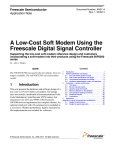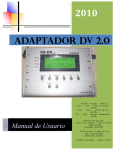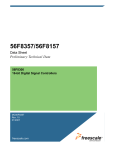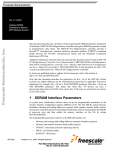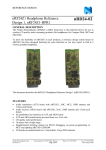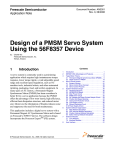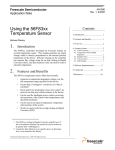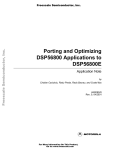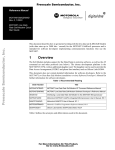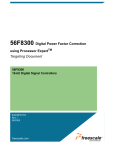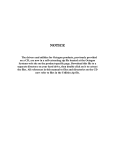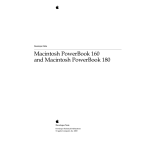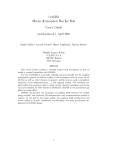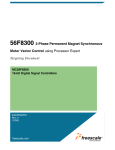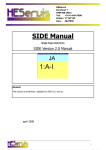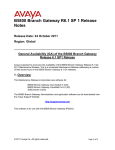Download A Low-Cost Soft Modem using the Freescale Digital Signal Controller
Transcript
A Low-Cost Soft Modem using the Freescale Digital Signal Controller Designer Reference Manual 56800E 16-bit Digital Signal Controllers DRM073 Rev. 0 07/2005 freescale.com A Low-Cost Soft Modem using the Freescale Digital Signal Controller Designer Reference Manual To provide the most up-to-date information, the revision of our documents on the World Wide Web will be the most current. Your printed copy may be an earlier revision. To verify that you have the latest information available, refer to http://www.freescale.com The following revision history table summarizes changes contained in this document. For your convenience, the page number designators have been linked to the appropriate location. Revision History Date Revision Level 07/2005 0 Description Initial release Page Number(s) N/A TABLE OF CONTENTS Chapter 1 Introduction Chapter 2 System Specification and Design 2.1 2.2 2.3 2.3.1 2.3.2 2.3.3 2.3.4 2.4 2.4.1 2.4.2 The Soft Modem System Concept . . . . . . . . . . . . . . . . . . . . . . . . . . . . . . . . . . . . . . . . Soft Modem Specification and Design . . . . . . . . . . . . . . . . . . . . . . . . . . . . . . . . . . . . . Test Harness Specification and Design . . . . . . . . . . . . . . . . . . . . . . . . . . . . . . . . . . . . Terminal Emulation One . . . . . . . . . . . . . . . . . . . . . . . . . . . . . . . . . . . . . . . . . . . . . Terminal Emulation Two . . . . . . . . . . . . . . . . . . . . . . . . . . . . . . . . . . . . . . . . . . . . . Terminal Emulation Three. . . . . . . . . . . . . . . . . . . . . . . . . . . . . . . . . . . . . . . . . . . . Terminal Emulation Four. . . . . . . . . . . . . . . . . . . . . . . . . . . . . . . . . . . . . . . . . . . . . Hardware Implementation, Set-up, and Operation . . . . . . . . . . . . . . . . . . . . . . . . . . . . Pulse Width Modulation Telephony Base Band Transmission . . . . . . . . . . . . . . . . Telephony Base Band Reception to Analog-to-Digital Converter . . . . . . . . . . . . . . 2-1 2-4 2-5 2-6 2-6 2-7 2-7 2-7 2-8 2-9 Chapter 3 Processor Expert Bean Utilization in the Soft Modem 3.1 3.2 3.3 3.4 3.5 3.6 3.7 3.8 3.9 3.10 3.11 3.12 3.13 3.14 3.15 CPU Bean. . . . . . . . . . . . . . . . . . . . . . . . . . . . . . . . . . . . . . . . . . . . . . . . . . . . . . . . . . . 3-2 MEM1:DSP_MEM Bean . . . . . . . . . . . . . . . . . . . . . . . . . . . . . . . . . . . . . . . . . . . . . . . . 3-4 The ADC1:ADC Bean. . . . . . . . . . . . . . . . . . . . . . . . . . . . . . . . . . . . . . . . . . . . . . . . . . 3-7 OutputTimer:Init_TMR Bean. . . . . . . . . . . . . . . . . . . . . . . . . . . . . . . . . . . . . . . . . . . . 3-10 IV1:InterruptVector Bean . . . . . . . . . . . . . . . . . . . . . . . . . . . . . . . . . . . . . . . . . . . . . . 3-12 Mdm1:DSP_v22bis Bean . . . . . . . . . . . . . . . . . . . . . . . . . . . . . . . . . . . . . . . . . . . . . . 3-14 InputTimer:Init_TMR Bean . . . . . . . . . . . . . . . . . . . . . . . . . . . . . . . . . . . . . . . . . . . . . 3-15 AS1:AsynchroSerial Bean . . . . . . . . . . . . . . . . . . . . . . . . . . . . . . . . . . . . . . . . . . . . . 3-17 RingDetect:PulseAccumulator Bean . . . . . . . . . . . . . . . . . . . . . . . . . . . . . . . . . . . . . 3-20 OffHook:BitIO Bean . . . . . . . . . . . . . . . . . . . . . . . . . . . . . . . . . . . . . . . . . . . . . . . . . . 3-22 TenthSecInt:TimerInt Bean. . . . . . . . . . . . . . . . . . . . . . . . . . . . . . . . . . . . . . . . . . . . . 3-23 TEL1:CallProgressToneDetection Bean. . . . . . . . . . . . . . . . . . . . . . . . . . . . . . . . . . . 3-25 TEL2:DTMFGenerate Bean . . . . . . . . . . . . . . . . . . . . . . . . . . . . . . . . . . . . . . . . . . . . 3-27 Mdm2 DSP_v21 Modem Software Bean . . . . . . . . . . . . . . . . . . . . . . . . . . . . . . . . . . 3-28 CTS1:56F8357EVM_LED_Yellow2 Bean . . . . . . . . . . . . . . . . . . . . . . . . . . . . . . . . . 3-29 Table of Contents, Rev. 0 Freescale Semiconductor Preliminary i Chapter 4 Conclusion 4.1 4.1.1 4.1.2 4.2 4.3 4.4 4.4.1 4.4.2 4.5 4.5.1 4.5.2 4.6 4.7 Test Set-up . . . . . . . . . . . . . . . . . . . . . . . . . . . . . . . . . . . . . . . . . . . . . . . . . . . . . . . . . . 4-1 Routine File Transfer Testing . . . . . . . . . . . . . . . . . . . . . . . . . . . . . . . . . . . . . . . . . 4-1 Bit Error Rate Testing . . . . . . . . . . . . . . . . . . . . . . . . . . . . . . . . . . . . . . . . . . . . . . . 4-2 Bit Error Rate Test Results. . . . . . . . . . . . . . . . . . . . . . . . . . . . . . . . . . . . . . . . . . . . . . 4-3 Dynamic Range Test Results . . . . . . . . . . . . . . . . . . . . . . . . . . . . . . . . . . . . . . . . . . . 4-15 Memory Utilization on the 56F8357 . . . . . . . . . . . . . . . . . . . . . . . . . . . . . . . . . . . . . . 4-16 Summary Memory Utilization . . . . . . . . . . . . . . . . . . . . . . . . . . . . . . . . . . . . . . . . 4-16 Complete Load Map . . . . . . . . . . . . . . . . . . . . . . . . . . . . . . . . . . . . . . . . . . . . . . . 4-17 Core Processor Loading and RTOS. . . . . . . . . . . . . . . . . . . . . . . . . . . . . . . . . . . . . . 4-36 Core Processor Load . . . . . . . . . . . . . . . . . . . . . . . . . . . . . . . . . . . . . . . . . . . . . . 4-36 Using RTOS to Run the Modem Concurrently with Other Tasks . . . . . . . . . . . . . 4-37 Peripheral Footprint . . . . . . . . . . . . . . . . . . . . . . . . . . . . . . . . . . . . . . . . . . . . . . . . . . 4-37 Conclusions . . . . . . . . . . . . . . . . . . . . . . . . . . . . . . . . . . . . . . . . . . . . . . . . . . . . . . . . 4-38 Appendix A Schematics Appendix B Low-Cost Soft Modem Bill of Materials Appendix C Layout and Governmental Certifications Low-Cost Soft Modem Designer Reference Manual, Rev. 0 ii Freescale Semiconductor Preliminary LIST OF FIGURES 2-1 2-2 2-3 2-4 2-5 2-6 2-7 2-8 3-1 3-2 3-3 3-4 3-5 3-6 3-7 3-8 3-9 3-10 3-11 3-12 3-13 3-14 3-15 3-16 3-17 3-18 3-19 3-20 3-21 3-22 3-23 3-24 3-25 3-26 Second Millennium Modem Architecture. . . . . . . . . . . . . . . . . . . . . . . . . . . . . . . . . 2-2 Third Millennium Modem Architecture. . . . . . . . . . . . . . . . . . . . . . . . . . . . . . . . . . . 2-3 Low-Cost Soft Modem System . . . . . . . . . . . . . . . . . . . . . . . . . . . . . . . . . . . . . . . . 2-4 Modem Analog Block Design . . . . . . . . . . . . . . . . . . . . . . . . . . . . . . . . . . . . . . . . . 2-5 Modem Test Set-up. . . . . . . . . . . . . . . . . . . . . . . . . . . . . . . . . . . . . . . . . . . . . . . . . 2-6 TD1 in to Active 4kHz 4th Order Filter to TP7. . . . . . . . . . . . . . . . . . . . . . . . . . . . . 2-8 TP7 to Level Set to XMIT . . . . . . . . . . . . . . . . . . . . . . . . . . . . . . . . . . . . . . . . . . . . 2-9 REC to Offset and Gain to ANA6 . . . . . . . . . . . . . . . . . . . . . . . . . . . . . . . . . . . . . 2-10 Modem Project Bean List . . . . . . . . . . . . . . . . . . . . . . . . . . . . . . . . . . . . . . . . . . . . 3-2 Cpu:56F8357 Properties . . . . . . . . . . . . . . . . . . . . . . . . . . . . . . . . . . . . . . . . . . . . . 3-3 Cpu:56F8357 on sdm pROM-xRAM target . . . . . . . . . . . . . . . . . . . . . . . . . . . . . . . 3-4 MEM1:DSP_MEM Properties . . . . . . . . . . . . . . . . . . . . . . . . . . . . . . . . . . . . . . . . . 3-5 MEM1:DSP_MEM Methods . . . . . . . . . . . . . . . . . . . . . . . . . . . . . . . . . . . . . . . . . . 3-6 MEM1:DSP_MEM Events . . . . . . . . . . . . . . . . . . . . . . . . . . . . . . . . . . . . . . . . . . . . 3-7 AD1:ADC Properties . . . . . . . . . . . . . . . . . . . . . . . . . . . . . . . . . . . . . . . . . . . . . . . . 3-8 AD1:ADC Methods . . . . . . . . . . . . . . . . . . . . . . . . . . . . . . . . . . . . . . . . . . . . . . . . . 3-9 AD1:ADC Events. . . . . . . . . . . . . . . . . . . . . . . . . . . . . . . . . . . . . . . . . . . . . . . . . . 3-10 OutputTimer:Init_TMR Properties . . . . . . . . . . . . . . . . . . . . . . . . . . . . . . . . . . . . . 3-11 OutputTimer:Init_TMR Methods . . . . . . . . . . . . . . . . . . . . . . . . . . . . . . . . . . . . . . 3-12 OutputTimer:Init_TMR Events. . . . . . . . . . . . . . . . . . . . . . . . . . . . . . . . . . . . . . . . 3-12 IV1:InterruptVector Properties. . . . . . . . . . . . . . . . . . . . . . . . . . . . . . . . . . . . . . . . 3-13 IV1:InterruptVector Methods . . . . . . . . . . . . . . . . . . . . . . . . . . . . . . . . . . . . . . . . . 3-13 IV1:InterruptVector Events . . . . . . . . . . . . . . . . . . . . . . . . . . . . . . . . . . . . . . . . . . 3-14 Mdm1:DSP_v22bis Properties . . . . . . . . . . . . . . . . . . . . . . . . . . . . . . . . . . . . . . . 3-14 Mdm1:DSP_v22bis Methods. . . . . . . . . . . . . . . . . . . . . . . . . . . . . . . . . . . . . . . . . 3-15 Mdm1:DSP_v22bis Events . . . . . . . . . . . . . . . . . . . . . . . . . . . . . . . . . . . . . . . . . . 3-15 InputTimer:Init_TMR Properties . . . . . . . . . . . . . . . . . . . . . . . . . . . . . . . . . . . . . . 3-16 InputTimer:Init_TMR Methods. . . . . . . . . . . . . . . . . . . . . . . . . . . . . . . . . . . . . . . . 3-17 InputTimer:Init_TMR Events . . . . . . . . . . . . . . . . . . . . . . . . . . . . . . . . . . . . . . . . . 3-17 AS1:AsynchroSerial Properties. . . . . . . . . . . . . . . . . . . . . . . . . . . . . . . . . . . . . . . 3-18 AS1:AsynchroSerial Methods . . . . . . . . . . . . . . . . . . . . . . . . . . . . . . . . . . . . . . . . 3-19 AS1:AsynchroSerial Events . . . . . . . . . . . . . . . . . . . . . . . . . . . . . . . . . . . . . . . . . 3-20 RingDetect:PulseAccumulator Properties . . . . . . . . . . . . . . . . . . . . . . . . . . . . . . . 3-21 RingDetect:PulseAccumulator Methods . . . . . . . . . . . . . . . . . . . . . . . . . . . . . . . . 3-21 List of Figures, Rev. 0 Freescale Semiconductor Preliminary v 3-27 3-28 3-29 3-30 3-31 3-32 3-33 3-34 3-35 3-36 3-37 3-38 3-39 3-40 3-41 3-42 3-43 3-44 4-1 4-2 4-3 4-4 4-5 4-6 4-7 4-8 4-9 4-10 4-11 4-12 4-13 4-14 RingDetect:PulseAccumulator Events . . . . . . . . . . . . . . . . . . . . . . . . . . . . . . . . . 3-22 OffHook:BitIO Properties. . . . . . . . . . . . . . . . . . . . . . . . . . . . . . . . . . . . . . . . . . . . 3-22 OffHook:BitIO Methods . . . . . . . . . . . . . . . . . . . . . . . . . . . . . . . . . . . . . . . . . . . . . 3-23 OffHook:BitIO Events . . . . . . . . . . . . . . . . . . . . . . . . . . . . . . . . . . . . . . . . . . . . . . 3-23 TenthSecInt:TimerInt Properties . . . . . . . . . . . . . . . . . . . . . . . . . . . . . . . . . . . . . . 3-24 TenthSecInt:TimerInt Methods . . . . . . . . . . . . . . . . . . . . . . . . . . . . . . . . . . . . . . . 3-25 TenthSecInt:TimerInt Events. . . . . . . . . . . . . . . . . . . . . . . . . . . . . . . . . . . . . . . . . 3-25 TEL1:CallProgressToneDetection Properties . . . . . . . . . . . . . . . . . . . . . . . . . . . . 3-26 TEL1:CallProgressToneDetection Methods . . . . . . . . . . . . . . . . . . . . . . . . . . . . . 3-26 TEL1:CallProgressToneDetection Events. . . . . . . . . . . . . . . . . . . . . . . . . . . . . . . 3-27 TEL2:DTMFGenerate Properties . . . . . . . . . . . . . . . . . . . . . . . . . . . . . . . . . . . . . 3-27 TEL2:DTMFGenerate Methods. . . . . . . . . . . . . . . . . . . . . . . . . . . . . . . . . . . . . . . 3-28 TEL2:DTMFGenerate Events . . . . . . . . . . . . . . . . . . . . . . . . . . . . . . . . . . . . . . . . 3-28 Mdm2:DSP_v21 Properties. . . . . . . . . . . . . . . . . . . . . . . . . . . . . . . . . . . . . . . . . . 3-29 Mdm2:DSP_v21 Methods . . . . . . . . . . . . . . . . . . . . . . . . . . . . . . . . . . . . . . . . . . . 3-29 CTS1:56F8357EVM_LED_Yellow2 Properties . . . . . . . . . . . . . . . . . . . . . . . . . . . 3-30 CTS1:56F8357EVM_LED_Yellow2 Methods . . . . . . . . . . . . . . . . . . . . . . . . . . . . 3-31 CTS1:56F8357EVM_LED_Yellow2 Events . . . . . . . . . . . . . . . . . . . . . . . . . . . . . 3-31 EIA1 Line. . . . . . . . . . . . . . . . . . . . . . . . . . . . . . . . . . . . . . . . . . . . . . . . . . . . . . . . . 4-4 EIA2 Line. . . . . . . . . . . . . . . . . . . . . . . . . . . . . . . . . . . . . . . . . . . . . . . . . . . . . . . . . 4-5 EIA3 Line. . . . . . . . . . . . . . . . . . . . . . . . . . . . . . . . . . . . . . . . . . . . . . . . . . . . . . . . . 4-6 EIA4 Line. . . . . . . . . . . . . . . . . . . . . . . . . . . . . . . . . . . . . . . . . . . . . . . . . . . . . . . . . 4-7 EIA5 Line. . . . . . . . . . . . . . . . . . . . . . . . . . . . . . . . . . . . . . . . . . . . . . . . . . . . . . . . . 4-8 EIA6 Line. . . . . . . . . . . . . . . . . . . . . . . . . . . . . . . . . . . . . . . . . . . . . . . . . . . . . . . . . 4-9 EIA7 Line. . . . . . . . . . . . . . . . . . . . . . . . . . . . . . . . . . . . . . . . . . . . . . . . . . . . . . . . 4-10 ETSI1 Line . . . . . . . . . . . . . . . . . . . . . . . . . . . . . . . . . . . . . . . . . . . . . . . . . . . . . . 4-11 ETSI2 Line . . . . . . . . . . . . . . . . . . . . . . . . . . . . . . . . . . . . . . . . . . . . . . . . . . . . . . 4-12 Null Line . . . . . . . . . . . . . . . . . . . . . . . . . . . . . . . . . . . . . . . . . . . . . . . . . . . . . . . . 4-13 EIA2 Line. . . . . . . . . . . . . . . . . . . . . . . . . . . . . . . . . . . . . . . . . . . . . . . . . . . . . . . . 4-14 Null Line Dynamic Range . . . . . . . . . . . . . . . . . . . . . . . . . . . . . . . . . . . . . . . . . . . 4-15 Soft Modem Peripheral Footprint . . . . . . . . . . . . . . . . . . . . . . . . . . . . . . . . . . . . . 4-37 Soft Modem Pin Utilization . . . . . . . . . . . . . . . . . . . . . . . . . . . . . . . . . . . . . . . . . . 4-38 Low-Cost Soft Modem Designer Reference Manual, Rev. 0 vi Freescale Semiconductor Preliminary About This Document This manual describes the use of a 56F8300 device in a low-cost soft modem application. Note:The 56F8357EVM was used as the test vehicle, but is no longer available. The 56F8367EVM will yield similar results. Audience This manual supports the Low-Cost Soft Modem Reference Design and customers incorporating a soft modem into their products into their products using the Freescale 56F8300 series. Organization This User’s Manual consists of the following sections: • Chapter 1, Introduction, offers a brief introduction to the soft modem application. • Chapter 2, System Specification and Design, describes the system specification and implementation of the soft modem application. • Chapter 3, Processor Expert Bean Utilization in the Soft Modem, illustrates the properties, methods and events for beans used in the application. • Chapter 4, Conclusion, details the performance of the soft modem application. • Appendix A, Schematics contains the schematics of the low-cost soft modem application • Appendix B, Low-Cost Soft Modem Bill of Materials describes layout and considerations in bringing a soft modem to market. • Appendix C, Layout and Governmental Certifications discusses layout and necessary approvals for products using modem technology. Preface, Rev. 0 Freescale Semiconductor Preliminary v Conventions This document uses the following notational conventions: Typeface, Symbol or Term Meaning Examples Courier Monospaced Type Code examples //Process command for line flash Italic Directory names, project names, calls, functions, statements, procedures, routines, arguments, file names, applications, variables, directives, code snippets in text ...and contains these core directories: applications contains applications software... Bold Reference sources, paths, emphasis ...refer to the Targeting DSP56F83xx Platform manual.... ...see: C:\Program Files\Freescale\help\tutorials Blue Text Linkable on-line ...refer to Chapter 7, License.... Number Any number is considered a positive value, unless preceded by a minus symbol to signify a negative value 3V -10 DES-1 ALL CAPITAL LETTERS # defines/ defined constants # define INCLUDE_STACK_CHECK Brackets [...] Function keys ...by pressing function key [F7] Quotation marks, “...” Returned messages ...the message, “Test Passed” is displayed.... ...CodeWarrior project, 3des.mcp is... ...the pConfig argument.... ...defined in the C header file, aec.h.... ...if unsuccessful for any reason, it will return “NULL”... Low-Cost Soft Modem Designer Reference Manual, Rev. 0 vi Freescale Semiconductor Preliminary Definitions, Acronyms, and Abbreviations The following list defines the acronyms and abbreviations used in this document. As this template develops, this list will be generated from the document. As we develop more group resources, these acronyms will be easily defined from a common acronym dictionary. Please note that while the acronyms are in solid caps, terms in the definition should be initial capped ONLY IF they are trademarked names or proper nouns. AGC Automatic Gain Control BERT Bit Error Rate Test LCMDC Low-Cost Modem Daughter Card RX Receive SNR Signal-to-Noise Ratio TX Transmit UUT Unit Under Test References The following sources were used to produce this book; we recommend that you have a copy of these references: • • • • • • • • • • • 56F8300 Peripheral User Manual, Freescale, MC56F8300UM 56F8367 Evaluation Module User Manual, Freescale, MC56F8367EVMUM TAS Series II Plus Telephone Network Emulator Operations Manual, 2700-2003, Version 2.40 TAS Series II Telephone Network Emulator UCO Option Operations Manual, 2700-2734, Version 1.20 TAS 240 Voiceband Subscriber Loop Emulator Operations Manual, 2700-2397, Version 1.20 Understanding Telephone Electronics, SAMS, Seventh printing 1987 ITU-T Recommendation V.22bis, 2400 Bits Per Second Duplex Modem Using The Frequency Division Technique Standardized For Use On The General Switched Telephone Network And On Point-to-point. ITU-T Recommendation V.21, 300 Bits Per Second Duplex Modem Standardized For Use On The General Switched Telephone Network. ITU-T Recommendation V.25, Automatic Answering Equipment and General Procedures for Automatic Callling Equipment on the General Switched Telephone Network, Including Procedures for Disabling of Echo Control Devices for Both Manually and Automatically Established Calls Measuring the Peak-to-Average Power of Digitally Modulated Signals, Charles J. Meyer, Senior Applications Engineer, Boonton Electronics, Application Note AN-50, 1 Apr. ‘93. CH1837A/7F/8A Data Access Arrangement Module Data Sheet, V.34bis High Speed DAA Module, Cermetek Microelectronics Preface, Rev. 0 Freescale Semiconductor Preliminary vii Low-Cost Soft Modem Designer Reference Manual, Rev. 0 viii Freescale Semiconductor Preliminary Chapter 1 Introduction This note presents the hardware and software design of a low-cost V.21/V.22/V.22bis soft modem. The design does not include a traditional telecommunications Pulse Code Modulation Coder/Decoder (PCM codec), but instead uses the ADC and PWM of the Freescale 56F8300 series to implement a less complex solution. An optional serial port with AT command set is included as a test fixture. Modem performance figures measured on the implementation are included for reference, as are complete implementation details. Introduction, Rev. 0 Freescale Semiconductor Preliminary 1-1 Low-Cost Soft Modem Designer Reference Manual, Rev. 0 1-2 Freescale Semiconductor Preliminary The Soft Modem System Concept Chapter 2 System Specification and Design This section describes the system used to implement the soft modem, as well as the motivation for such a system. The system specification is followed by a block diagram and discussion of implementation. 2.1 The Soft Modem System Concept A soft modem is one that can be used to modulate/demodulate data to be sent serially over an analog channel directly, without the need for a serial data path to another entity to supply data or control signals. It includes a simple way to dial phone numbers, detect ringing signals, control the hook relay of the DAA, input and output analog data, connect with remote modems and communicate with them. Complete control of the modem is embedded within the same host computer performing other system functions, such as alarm monitoring or motion control. A soft modem is the enabling ingredient that allows combining the DTE/DCE into one entity. This differs from traditional communication systems, which are broken into two parts: a DTE, or data terminal equipment, and a DCE, or data communication equipment. Traditionally, these equipments communicated via a 25-pin serial interface comprised of such signals as are described in the V.14, V.25 and V.22bis (and many other) specifications. These signals were used for flow control and complex signaling between the DTE and DCE as to what respective states they might have been in. With the advent of the AT command set in the 1980’s, many of these signals fell into disuse and the 25-pin DTE/DCE interface is now more typically found to be a nine-pin interface. The difference is made up in providing a complex set of commands and responses that attempt to keep the DTE and DCE in sync, depicted in Figure 2-1. System Specification and Design, Rev. 0 Freescale Semiconductor Preliminary 2-1 Application with program that talks to modem Modem Phone line Figure 2-1. Second Millennium Modem Architecture In the 1990’s, this interface all but disappeared when a modem designed only for Windows was developed. This spoofed the serial communications to the DCE, actually performing much of the modem function on the host processor. Only digital signal processing was done on another processor closely coupled to the PC on its bus. The DTE and DCE still were two intelligent processors, but the old serial interface was gone. When the DTE and DCE were merged into one processor around the turn of the century, the need for such a cable or even bus, vanished, as did the need for a “serial port”. This is in fact how modems in PCs are implemented today. The host processor is powerful enough to implement the modem algorithms and does away with the DCE as a separate intelligent device. All that is needed is a way to send and receive analog signals over the phone line and to protect telephone equipment using the DAA. The “serial ports”, used only for PC communication software compatability, are complete spoofs. This same elegant architecture, shown in Figure 2-2, can now exist in embedded systems. The project described here shows the simplicity of such a design, how few resources of the processor it takes, and how well it performs on USA average lines. This design even omits the standard telecommunications codec, instead using a Pulse Width Modulation (PWM) for output and Analog-to-Digital Converter (ADC) for input. Since both of these peripherals are readily available from the many peripherals on one 56F8300 series device, along with more processing power than required from the single core, the design is a true one-chip, one-core system that includes telecommunications ability with room for even more system functionality. Low-Cost Soft Modem Designer Reference Manual, Rev. 0 2-2 Freescale Semiconductor Preliminary The Soft Modem System Concept Application with soft modem Phone line Figure 2-2. Third Millennium Modem Architecture This approach has many applications in embedded systems. For example, a security system consisting of a single processor charged with monitoring local security sensors communicates directly over phone lines to a central reporting location. This reporting may be for the purpose of conveying the state of security. Another application would be a portable medical device, such as a heart monitor, that could periodically interface directly to a phone line without the need for an external modem (or costly modem chip on board) of any kind. Without the DCE/DTE split, such a device would be more reliable and less expensive, while consuming less power. While it would be possible to split the design into a DCE and a DTE, this would add cost, not just for the additional processor, but for the two serial ports required to connect them as well as for the software in both parts used for communication between the DTE and DCE, the interrupts and context saving and restoring that these engender. It would also add a potential failure scenario when the DCE and DTE do not observe each other’s states in a timely manner. See the right side of Figure 2-3 for a block diagram illustrating a low-cost soft modem system utilizing Freescale’s 56F8357 controller. The left side of the same figure shows the test harness integrated with the system. System Specification and Design, Rev. 0 Freescale Semiconductor Preliminary 2-3 Soft Modem Portion Test Fixture Portion Serial communication of test data is full duplex with flow control for data from PC in the test fixture PC data SCI “Ring Signal”—used for ring detect GPIO ADC Amplifier 56F8357 GPIO flow control Receive from Phone Line DAA PWM Low-Pass Filter Transmit to Phone Line GPIO Off/On Hook Control Phone Line Figure 2-3. Low-Cost Soft Modem System 2.2 Soft Modem Specification and Design Figure 2-4 shows how the basic modem, DTMF, and call progress detection are implemented. The DAA control signal, ring detect signal, flow control signal (for testing only) and the serial port (for testing only) are not shown. The modem incorporates portions of the following standards as they apply to a soft modem: V.25, V.21, V.22, V.22bis, all implemented on the host controller. The portions of these standards related to the DTE/DCE interface are simply not required for a soft modem. PWM and ADC peripherals on the DSC pass digital samples at 7200 samples per second (SPS) for the modems and DTMF generation software. A sampling rate of 8000 SPS is used for the call progress software, used to detect dial tone. The smaller the sampling rate, the less work for the processor, and, subsequently, the less power used. The rate of 7200 SPS is ideal for these modems. Low-Cost Soft Modem Designer Reference Manual, Rev. 0 2-4 Freescale Semiconductor Preliminary Test Harness Specification and Design PWM Signal Phone Line to PSTN Low-pass Filter Controller DAA Analog Signal Gain & Offset Adjust High Voltage Figure 2-4. Modem Analog Block Design 2.3 Test Harness Specification and Design The test harness for the soft modem application consists of some of the resources of the 56F8357 and some external test equipment, depicted in Figure 2-5. The controller and the telco connection to the controller are the only parts of this figure that are not purely test equipment. The resources of the 56F8357 device used for testing consist of an asynchronous serial comminication port and associated beans and software. This port is used to support an AT command set which is used only for testing; it does not comprise an essential element of the soft modem design. Data and commands are alternately communicated thru this test channel. Both online and offline commands are supported. Online commands may be issued after the escape sequence puts the test fixture into the online command state. Offline commands may be issued when no connection is in progress. Online commands supported are: • ato, which returns to online data state • ath, which hangs up the phone • atz, which hangs up the phone and performs a soft reset of the modem • +++ escape sequence, with three second pre- and post-guard times Offline commands supported are: • ata causes the modem to go offhook and answer It is not necessary to use this command, since the test fixture will automatically answer two seconds after the first ring • atd<string> sets the number to dial string When this string is set to the nonempty condition, the soft modem dials that number in the string and attempts a connection. (A production program interfacing to the soft modem would simply set this string to effect a dialed connection from the soft modem.) • ati issues the modem test fixture model and version number • atq1 puts the AT command set into quiet mode, where it operates without responding • atq0 undoes the atq1 command • atz performs a soft reset of the soft modem, which hangs up the phone and frees RAM resources System Specification and Design, Rev. 0 Freescale Semiconductor Preliminary 2-5 • at+0 puts the modem into V.21 mode, where it will attempt to force all subsequent connections; a modem soft reset is also performed • at+2 puts the modem into V.22/V.22bis mode, where the modem will attempt to force all subsequent connections; a modem soft reset is also performed The online data state of the test fixture is attained with the industry-standard escape sequence, consisting of a delay period of three seconds of no traffic on the serial test channel, three “plus” characters, and another three seconds of no activity on the serial test channel. Connect messages are issued, indicating the line speed. The serial test channel operates at a fixed 2400 baud. Characters are buffered into the test fixture for transmission and reception to and from the test fixture queues. Terminal Emulation 1 Terminal Emulation 2 Serial 2400 Hayes Accura V.92 Terminal Emulation 3 Serial 9600 Control TAS Series II Plus Telco Terminal Emulation 4 Serial 9600 Control Serial 2400 TAS Model 240 Switch to Line Emulator Connections Telco Controller Figure 2-5. Modem Test Set-up The external test equipment consists of two types, that connected to the RJ11 telco jack of the soft modem, and that connected to a DB9 async serial port on the EVM. The telco jack is connected to equipment that simulates the USA average Public Switched Telephone Network (PSTN) connection to an off-the-shelf modem, a Hayes Accura V.92 modem. This PSTN simulation equipment consists of the TAS Series II Plus unit and the TAS Model 240 unit. 2.3.1 Terminal Emulation One Terminal Emulation One runs HyperTerminal on a PC at 2400 BPS, 8 bits data, no parity, 1 stop bit on a communication port. It runs a binary file transfer using one of the protocols included with HyperTerminal. It is connected to a Hayes Accura modem, where the AT command set is used to directly control the modem. 2.3.2 Terminal Emulation Two Terminal Emulation Two is a HyperTerminal session at 9600 baud used to control the TAS Series II Plus unit. This unit is programmed to simulate USA average lines. Low-Cost Soft Modem Designer Reference Manual, Rev. 0 2-6 Freescale Semiconductor Preliminary Hardware Implementation, Set-up, and Operation 2.3.3 Terminal Emulation Three Terminal Emulation Three controls the TAS Model 240, which for these tests supplies NULL line. 2.3.4 Terminal Emulation Four Terminal Emulation Four is HyperTerminal on a PC at 2400 BPS 8 bits data, no parity, 1 stop bit, hardware flow control. It is the peer of Terminal Emulation One and runs the other end of the binary file transfer. The active signals in the DB9 include TX data, RX data, and one hardware flow control signal used to signal the PC when it may or may not send data. Flow control in the other direction was found to be unnecessary; due to the abundant resources of the PC, it never became flooded with data from the controller at 2400 BPS. 2.4 Hardware Implementation, Set-up, and Operation A standard off-the-shelf Freescale 56F8357EVM was used for this project. The Low-Cost Freescale Modem Demonstration Kit comes with a 56F8367EVM and a Low-Cost Modem Daughter Card (LCMDC) in one box. The EVM has a connector for this daughter card. The LCMDC was developed to house the Data Access Arrangement (DAA) as well as conditioning circuits for the single PWM signal from the EVM mother board. To assemble the modem, snap the daughter card into the connector after making the following revisions to the EVM: • To wire ring signal for detection by the controller, connect these two signals: — PWMA 1 (Pin 2, J7) source is ring indicator from the daughter card — Quadrature Decoder 0, PHASEA0 (Pin 1, J15) destination • To wire flow control of data from serial test device to the controller, connect these two signals and a capacitor: — SCI 1 TXD1 (Pin 1, J14) source — RTS (Pin 1, J11) destination — One end of a 39pF cap to RTS, the other end to ground • Clip pins 3, 4, 5, 6 of J8 to provide clearance for the DAA high voltage section of the daughter card The first connection connects the ring signal from the DAA to a counter, enabling ring detection functionality. The second connection connects a GPIO for flow control. To avoid noise-induced glitches on the flow control signal, a small capacitor (39pF) should connect the RTS signal to ground. The Low-Cost Freescale Modem Demonstration Kit, available for evaluation upon reservation, contains an EVM factory modified as specified previously. The kit also includes documentation, as well as the LCMDC and required cables. System Specification and Design, Rev. 0 Freescale Semiconductor Preliminary 2-7 2.4.1 Pulse Width Modulation Telephony Base Band Transmission The signal to be transmitted over the phone line is developed first as a PWM signal; its duty cycle is the analog of the signal value. This signal is then filtered to produce a real analog signal in the voice band. In the hardware it is done as in the following description. One of the PWM channels of the 56F8367 outputs a PWM signal on pin 130, Timer D, Channel 1 (TD1). This signal is available on the daughter card via pin 70 of the connector to the EVM. This PWM is associated with the OutputTimer bean, shown in Figures 3-10 through 3-12. This signal enters from the left of Figure 2-6, where it is limited to 4kHz by a 4th order active low-pass filter. The filtered signal is then passed on to the left of Figure 2-7 for level setting. Figure 2-6. TD1 in to Active 4kHz 4th Order Filter to TP7 The ouput, XMIT, from Figure 2-6 is then passed to the XMIT input of a Cermetek CH 1837A DAA whose output level is set to -9dBm via adjustment of R18. R17 is not populated. Low-Cost Soft Modem Designer Reference Manual, Rev. 0 2-8 Freescale Semiconductor Preliminary Hardware Implementation, Set-up, and Operation Figure 2-7. TP7 to Level Set to XMIT 2.4.2 Telephony Base Band Reception to Analog-to-Digital Converter Level adjustment and signal offset calibration are performed with the circuit shown in Figure 2-8. The REC signal is from the DAA, the received telephony signal. After level adjustment and offset adjustment, the signal is passed directly to the MC56F8357’s ADC, where it is sampled per the bean configuration shown in Figures 3-7 through 3-9. System Specification and Design, Rev. 0 Freescale Semiconductor Preliminary 2-9 Figure 2-8. REC to Offset and Gain to ANA6 Complete schematics for the Low-Cost Modem Daughter Card ( LCMDC) are included in Appendix A. Note: The LCMDC is available for evaluation from the factory on request. Low-Cost Soft Modem Designer Reference Manual, Rev. 0 2-10 Freescale Semiconductor Preliminary Chapter 3 Processor Expert Bean Utilization in the Soft Modem Version 7.1 of Metrowerks CodeWarrior for the Freescale 56F8300 family was used to develop all of the code. Much of the code was generated automatically after GUI selections were made from simple menus presented after the basic system’s (software/hardware combinations) building blocks were selected. Processor Expert beans encapsulate these basic system blocks. For the most part, this project was simply the selection and configuration of these beans. All of the beans are documented in this section so that the modem may be constructed directly from these beans, together with the code which is supplied separately. A bean has properties, methods, and events. Once a bean is added to a project, it must be configured in these three areas. The complete list of properties, methods, and events is illustrated for each bean in the project, along with a commentary on the bean’s usage. When Processor Expert is called upon to generate code, it will use the configured beans to generate most of the code required for the soft modem. The user-written code that must be added to complete the project is documented in a separate document; contact your Freescale representative. Processor Expert simplified the construction of the software by encapsulating peripheral support into beans. For example, there is a bean for an asynchronous serial port, used to form a test channel over which the AT commands were interfaced to the modem. The properties include such items as baud rate, chosen to be 2400 baud. Another property is used to associate the bean with a particular set of pins on the device. Methods are a way to interface the main program to use the peripheral. Code for methods can be drag-and-dropped into the program. Events of the bean facilitate installing user-defined functions to be performed by an Interrupt Service Routine (ISR) used with the bean. Modem data pumps are also added as beans. The software project is formed by first selecting blank Processor Expert Stationery, then adding and configuring the beans. User-written software programs are added as a final step. Pop-up help on the methods for using the beans along with the drag-and-drop feature makes using the processor simple. The bean name (given at the time the bean is added to a project by the designer) is followed a colon, then the generic bean type. The soft modem software project consists of the beans depicted in Figure 3-1. The soft modem has been implemented on several members of the DSC family, including the 56F8323, 56F846, 56F8357 (as in this note), and 56F8367 (as shipped with complete project and source code for demonstration/evaluation purposes). Processor Expert Bean Utilization in the Soft Modem, Rev. 0 Freescale Semiconductor Preliminary 3-1 Figure 3-1. Modem Project Bean List 3.1 CPU Bean There are three CPUs listed in the CPUs folder in Figure 3-1. The relevant CPU is checked. This is the one used in the active target, sdm pROM xRAM, or small memory model wherein the constants in data xRAM are initialized from program Flash (pROM). The CPU bean has the default settings. Double clicking on the CPU bean shows its properties, as shown in Figure 3-3. It’s easy to replace this bean with one for the other EVM’s in this family, such as the 56F8367EVM, which contain more system resources. The pROM xRAM target was chosen to develop this modem because there is plenty of pROM, so the constants that must be used to initialize part of RAM are stored first in pROM. The alternative would be to store them in xROM or to have the debugger run the application out of RAM. In order for the board to run without the debugger, the most intelligent option is to store the constants in pROM, then copy them to xRAM. This allows the entire application to be stored in nonvolatile memory with minimal use of scarce resources, explaining the pROM xRAM target choice. One of the important tabs of the CPU bean is the build options tab. Note the dynamic memory allocation at the bottom of the build options list. This allows most of the memory for the soft modem to be deallocated when the soft modem is not in use. Low-Cost Soft Modem Designer Reference Manual, Rev. 0 3-2 Freescale Semiconductor Preliminary CPU Bean Figure 3-2. Cpu:56F8357 Properties Processor Expert Bean Utilization in the Soft Modem, Rev. 0 Freescale Semiconductor Preliminary 3-3 Figure 3-3. Cpu:56F8357 on sdm pROM-xRAM target 3.2 MEM1:DSP_MEM Bean This bean defines internal xRAM for use by the other related beans. Internal memory is much faster than external memory. The most notable feature on this configuration is the .x_Dynmem at the bottom of Figure 3-3, which must be present in order to provide dynamic memory services for the soft modem. Since the modem is not the only function in a real application, when it is not in operation, it is recommended that it give back all of its RAM memory. This can be most easily accomplished with the help of the dynamic memory services provided by Processor Expert. Low-Cost Soft Modem Designer Reference Manual, Rev. 0 3-4 Freescale Semiconductor Preliminary MEM1:DSP_MEM Bean Figure 3-4. MEM1:DSP_MEM Properties Processor Expert Bean Utilization in the Soft Modem, Rev. 0 Freescale Semiconductor Preliminary 3-5 Figure 3-5. MEM1:DSP_MEM Methods These are the various methods available for the algorithms to allocate memory. A major advantage of having so many classes of memory available is to allow the algorithm to specify the arrangement of operands in memory to minimize wait states. Low-Cost Soft Modem Designer Reference Manual, Rev. 0 3-6 Freescale Semiconductor Preliminary The ADC1:ADC Bean Figure 3-6. MEM1:DSP_MEM Events 3.3 The ADC1:ADC Bean The InputTimer is used to trigger the ADC conversion. Once it is triggered, it takes eight rapid-fire samples, which are later averaged. The averaging reduces noise contribution to the signal. Processor Expert Bean Utilization in the Soft Modem, Rev. 0 Freescale Semiconductor Preliminary 3-7 Figure 3-7. AD1:ADC Properties Low-Cost Soft Modem Designer Reference Manual, Rev. 0 3-8 Freescale Semiconductor Preliminary The ADC1:ADC Bean Figure 3-8. AD1:ADC Methods Processor Expert Bean Utilization in the Soft Modem, Rev. 0 Freescale Semiconductor Preliminary 3-9 Figure 3-9. AD1:ADC Events 3.4 OutputTimer:Init_TMR Bean This bean supplies the PWM signal which is converted to an analog output signal by the low-pass filter, then passed to the DAA and, finally, to the telephone circuit. After the code is generated, the duty cycle is manipulated with PESL commands. The frequency remains constant, as does the “sampling” rate for this output. Most of the code runs with sampling rates of 7200 samples per second. Only the call progress function runs at 8000 samples per second, but since it does not output, it does not use this bean. Therefore, this bean is always used to output 7200 samples per second in the soft modem. This implies that the cutoff of the subsequent low-pass filter could be 3600Hz, rather than 4000Hz. However, any resultant artifacts are out of the signal band but within the required channel band and should not contribute to noise. Thus, 4000Hz is a good figure to use. Low-Cost Soft Modem Designer Reference Manual, Rev. 0 3-10 Freescale Semiconductor Preliminary OutputTimer:Init_TMR Bean Figure 3-10. OutputTimer:Init_TMR Properties Processor Expert Bean Utilization in the Soft Modem, Rev. 0 Freescale Semiconductor Preliminary 3-11 Figure 3-11. OutputTimer:Init_TMR Methods Figure 3-12. OutputTimer:Init_TMR Events 3.5 IV1:InterruptVector Bean The misaligned LongWordISR is supplied only to detect a misaligned LongWord interrupt. This does not occur in the project as provided, but is useful to illustrate how to hook an ISR. Low-Cost Soft Modem Designer Reference Manual, Rev. 0 3-12 Freescale Semiconductor Preliminary IV1:InterruptVector Bean Figure 3-13. IV1:InterruptVector Properties Figure 3-14. IV1:InterruptVector Methods Processor Expert Bean Utilization in the Soft Modem, Rev. 0 Freescale Semiconductor Preliminary 3-13 Figure 3-15. IV1:InterruptVector Events This bean does not generate any place to put “event” code in Events.c. Instead, it is up to the programmer to locate his ISR code. 3.6 Mdm1:DSP_v22bis Bean This software bean generates modem code for the V22bis/V.22 modem data pump. Most of the code is written in optimized Assembly language. It also generates the API in C. Memory Management makes it possible to set up the modem on a per-call basis. Since V.21 rather than V.22bis may be in use, it is useful to preserve this dynamic property. When a V.21 call is on, the V.22bis call’s resource, its memory, is deallocated, and vice versa. Also, when there is no active call, the modem is not taking RAM resources, because the Memory Management feature is used. Figure 3-16. Mdm1:DSP_v22bis Properties Low-Cost Soft Modem Designer Reference Manual, Rev. 0 3-14 Freescale Semiconductor Preliminary InputTimer:Init_TMR Bean Figure 3-17. Mdm1:DSP_v22bis Methods The v22bisControl method is for future expansion of the data pump. Section 3.7 illustrates the use of other methods. Figure 3-18. Mdm1:DSP_v22bis Events No events are needed because the modem is called. When it has data or needs data, it calls the application program back at a designated function to deliver or collect data. Since no event is needed, there is no context switch and the code is more efficient. 3.7 InputTimer:Init_TMR Bean This bean is responsible for timing the ADC sample reads and normally operates at 7200 samples per second. Using the PESL commands, the peripheral is modified to sample at 8000 samples per second during call progress. This dynamic sampling rate avoids the use of any sample rate conversion code. Processor Expert Bean Utilization in the Soft Modem, Rev. 0 Freescale Semiconductor Preliminary 3-15 Figure 3-19. InputTimer:Init_TMR Properties Low-Cost Soft Modem Designer Reference Manual, Rev. 0 3-16 Freescale Semiconductor Preliminary AS1:AsynchroSerial Bean To alter the sampling rate without having to stop or reset anything, the Timer Compare Register 1 is changed to a smaller number on the fly, effecting 8000 samples per second with PESL commands during call progress detection. Be sure to enable the PESL commands in the project, since the soft modem uses them. If this is not enabled, the compiler will report no prototype. Figure 3-20. InputTimer:Init_TMR Methods Figure 3-21. InputTimer:Init_TMR Events 3.8 AS1:AsynchroSerial Bean This bean was set up for 2400 baud. It actually does not matter what baud rate is used, as long as it is at least 2400 baud. The buffering is done in the modem, and hardware flow control assures that the modem is not overrun with data. Both V.21 and V.22bis use 2400 baud; the rate conversion is done by the modem. Processor Expert Bean Utilization in the Soft Modem, Rev. 0 Freescale Semiconductor Preliminary 3-17 Figure 3-22. AS1:AsynchroSerial Properties Notice that block, not character, input/output is used. All interrupts are at the same priority throught the project. Low-Cost Soft Modem Designer Reference Manual, Rev. 0 3-18 Freescale Semiconductor Preliminary AS1:AsynchroSerial Bean Figure 3-23. AS1:AsynchroSerial Methods Use SendBlock to send a block of characters to the serial port and use RecvBlock to receive a block of characters. Simply drag-and-drop these methods into the application code as required. Processor Expert Bean Utilization in the Soft Modem, Rev. 0 Freescale Semiconductor Preliminary 3-19 Figure 3-24. AS1:AsynchroSerial Events 3.9 RingDetect:PulseAccumulator Bean Ring detect uses the Quadrature Decoder hardware to preprocess the ring signal, reducing the MIP load to process it and filtering out spurious ring signals. Early telephones used a human-crank-powered generator to generate the high voltage ring signal. Generators and motors are really the same, except that one is driven mechanically and the other electrically. That is why the Quadrature Decoder, normally used to monitor motors, is an ideal peripheral to count and filter the ring pulses. Note the filtered input property highlighted in Figure 3-25, which cuts down on CPU interrupts by a factor of 255. It also gives a very robust ring detection, filtering out events such as “tinkle”, which occurs when an extension on the line is dialed with pulse dialing, or repeatedly lifted and replaced in the cradle. Some ring detectors will falsely trigger on tinkling. Because the quadrature decoder hardware filters out such events, the CPU is not even interrupted for a tinkle. Low-Cost Soft Modem Designer Reference Manual, Rev. 0 3-20 Freescale Semiconductor Preliminary RingDetect:PulseAccumulator Bean Figure 3-25. RingDetect:PulseAccumulator Properties Figure 3-26. RingDetect:PulseAccumulator Methods Processor Expert Bean Utilization in the Soft Modem, Rev. 0 Freescale Semiconductor Preliminary 3-21 Figure 3-27. RingDetect:PulseAccumulator Events 3.10 OffHook:BitIO Bean This bitIO is used to control the onhook/offhook status of the DAA. Never take the phone from the onhook to the offhook condition while the phone is ringing, as this may damage the DAA circiuts. The autoanswer feature of the soft modem assures that this will not happen. Figure 3-28. OffHook:BitIO Properties Low-Cost Soft Modem Designer Reference Manual, Rev. 0 3-22 Freescale Semiconductor Preliminary TenthSecInt:TimerInt Bean Figure 3-29. OffHook:BitIO Methods ClrVal and SetVal are methods used to take the modem on and off the hook. When onhook, the modem is not connected to the phone line, but when offhook, it is connected. This term again goes back to the antique telephone design. Figure 3-30. OffHook:BitIO Events 3.11 TenthSecInt:TimerInt Bean This bean is used to generate an interrupt once every 1/10 second for the ring-detection and AT command set state machines. The AT command set must run a three-second timer when it is online (connected to another modem), to prevent data of ‘+++’ being construed as a request to enter the online commnand state. Processor Expert Bean Utilization in the Soft Modem, Rev. 0 Freescale Semiconductor Preliminary 3-23 Figure 3-31. TenthSecInt:TimerInt Properties Low-Cost Soft Modem Designer Reference Manual, Rev. 0 3-24 Freescale Semiconductor Preliminary TEL1:CallProgressToneDetection Bean Figure 3-32. TenthSecInt:TimerInt Methods Figure 3-33. TenthSecInt:TimerInt Events 3.12 TEL1:CallProgressToneDetection Bean This software bean generates the Call Progress Tone Detection code used to detect dial tone. Note the available methods, shown in Figure 3-35. When moused over in the project window, the method’s documentation pops up. Processor Expert Bean Utilization in the Soft Modem, Rev. 0 Freescale Semiconductor Preliminary 3-25 Figure 3-34. TEL1:CallProgressToneDetection Properties Figure 3-35. TEL1:CallProgressToneDetection Methods Low-Cost Soft Modem Designer Reference Manual, Rev. 0 3-26 Freescale Semiconductor Preliminary TEL2:DTMFGenerate Bean Figure 3-36. TEL1:CallProgressToneDetection Events 3.13 TEL2:DTMFGenerate Bean This bean generates the software to generate the samples needed for DTMF dialing and supports both 7200 and 8000 samples per second. The soft modem uses 7200 samples per second, consuming less cycles and energy. The resources of this bean are only used (RAM-allocated) while the bean is in use, due to the use of Memory Management. Figure 3-37. TEL2:DTMFGenerate Properties Processor Expert Bean Utilization in the Soft Modem, Rev. 0 Freescale Semiconductor Preliminary 3-27 Figure 3-38. TEL2:DTMFGenerate Methods Figure 3-39. TEL2:DTMFGenerate Events 3.14 Mdm2 DSP_v21 Modem Software Bean One of the two modem beans dropped into this project, Mdm2 generates the V.21 modem data pump code. This code does not do anything with answer tone or asynchronous characters. In the case of V.21, ANS processing for receive and transmit are both supplied in the applicaton code. If ANS tone were not needed, V.21 would connect very quickly, allowing very rapid delivery of a real-time message. V.21 does not require training. As soon as the bean is called, it presents carrier and starts exchanging data. Low-Cost Soft Modem Designer Reference Manual, Rev. 0 3-28 Freescale Semiconductor Preliminary CTS1:56F8357EVM_LED_Yellow2 Bean Figure 3-40. Mdm2:DSP_v21 Properties Figure 3-41. Mdm2:DSP_v21 Methods 3.15 CTS1:56F8357EVM_LED_Yellow2 Bean This Clear-to-Send (of hardware flow control application) bean takes a bit IO that drives an LED on the EVM and employs it for the Clear-to-Send signal to the PC serial interface. Without this hardware flow control mechanism, the PC tends to overrun the modem during binary file transfers using XMODEM, or YMODEM, or ZMODEM binary file transfer protocols with HyperTerminal. Processor Expert Bean Utilization in the Soft Modem, Rev. 0 Freescale Semiconductor Preliminary 3-29 Figure 3-42. CTS1:56F8357EVM_LED_Yellow2 Properties Note the right angle bracket on the Output PIN on the top element of Figure 3-42, which indicates that this bean encapulates another bean. By clicking on the right angle bracket, a second screen is presented, shown in the lower element of Figure 3-42 and displays the actual pin used for the Clear-to-Send signal sent to the PC serial port. This bean also toggles an LED so the user can see when flow control is actually being relied on. This On initial value really means that flow is restricted initially. Low-Cost Soft Modem Designer Reference Manual, Rev. 0 3-30 Freescale Semiconductor Preliminary CTS1:56F8357EVM_LED_Yellow2 Bean Figure 3-43. CTS1:56F8357EVM_LED_Yellow2 Methods The On method actually stops the flow from the PC, whereas the Off method allows it to resume. This is due to the simple jumper wire connection on the EVM to install the signal. The jumper wire conveys the drive to the RTS pin on the EVM on JG11. Figure 3-44. CTS1:56F8357EVM_LED_Yellow2 Events Processor Expert Bean Utilization in the Soft Modem, Rev. 0 Freescale Semiconductor Preliminary 3-31 Low-Cost Soft Modem Designer Reference Manual, Rev. 0 3-32 Freescale Semiconductor Preliminary Test Set-up Chapter 4 Conclusion The modem is fully capable of error-free operation over average telephone lines in the USA. Limitations to performance are inherent in the limited dynamic range of the AGC. If desired, such limitation may be overcome by the addition of a hardware AGC circuit, since the amplitude variation of a land line telephone circuit over time is not dramatic. Modem performance curves indicate that the modem meets the performance standards required for V.22bis and V.21 operation. Transfers of binary files millions of bits long were performed without incident. 4.1 Test Set-up 4.1.1 Routine File Transfer Testing To set up routine file transfer, the TAS Series II was configured with the script in Example 4-1, which depicts the average USA line. Code Example 4-1. Routine File Transfer Testing /ad,s03=1,s07=1,c3/ /exch,bal=1/ /file:cseq=usa1/ /io,i-100,l-230,r-100,t-230/ /ad,i3/ /gd,w17,x00,y16,z00/ /rn,l320,s1/ /nl,q520,c500,m0,x1,y1/ /fs,f+1250,m0,s1/ /pj,l0364,f1200,w0,s1/ The Hayes modem was simply configured with factory defaults: ATZ For 300 baud testing, the Hayes modem was limited to 300 baud with the following command: ATS37=3 which configured the modem for V.21. The Freescale Low-Cost Soft Modem, the unit under test (UUT), was configured for V.21 with the AT+ command. Conclusion, Rev. 0 Freescale Semiconductor Preliminary 4-1 4.1.2 Bit Error Rate Testing All Bit Error Rate Test (BERT) runs were performed at 2400 bits per second, V.22bis mode. For bit error rate tests on the several standard line configurations, white noise was used for the impairment. The contribution of the various lines to the tests are their phase maginitude responses. These results are depicted in Figures 4-1 through 4-11. For the dynamic range test, a null line was used. The null line has a flat phase magnitude response. The purpose of this test is to show the lowest input level to the modem at which it will function on a flat line. The Hayes equipment was on the A equipment side, the UUT on the B equipment side. Since the V.22bis contains a built in scrambler, modem BERT perfomance was measured as a function of the number of error characters that were received when no characters were being transmitted. A test frame of 7 minutes, or about 1 million bits, was used for each test. One synchronous bit error results in at least one asychronous character error because it is seen as a start bit. The idle line condition is marking, or 1. The following parameters were used to obtain SNR BERT raw data, available on request, from which these figures were graphed: • IR -- the level at the A equipment after passing from the modem transmitter through the Line to the TAS Series II, in dBm • LR -- the signal level transmitted from the TAS Series 2 into the Line and hence to the modem RX on the A side • RR -- the level at the B equipment after passing from the modem TX thru the Line t to the TAS Series II • TR -- the signal level TX from the TAS Series II central office into the Line and hence to the Modem RX on the B side • RL -- the noise level in dBrn ( to convert to dBm, subtract 90); noise was white over 5kHz C-Message • Dir -- the signal direction affected by noise, which is added as it leaves the TAS Series II into the line. • I, L, R, and T -- initialized so that the AGC does not have to travel too far during AGC operations with the TAS Series II • IR, LR, RR, TR -- measured after the AGC; where reported, complete AGCs have been performed The AGC feature of the TAS Series II was used to align signal levels in the digital portion of the TAS Series II. In each of the tests shown in Figures 4-1 through 4-11, the units used were a Hayes Accura V.92 modem and the UUT, which was the 56F8357EVM with the LCMDC. Low-Cost Soft Modem Designer Reference Manual, Rev. 0 4-2 Freescale Semiconductor Preliminary Bit Error Rate Test Results 4.2 Bit Error Rate Test Results In each of the lines tested, the line impairment was present in both lines from the central office simulation and to the central office simulation. This resulted in twice the dynamic range requirement imposed by using only one line impairment for one of the legs of the call. As a result, the IEA5 test shows the result of hitting the dynamic range limitation due to the cascaded shaping (magnitude response vs. frequency) of two IEA5 lines in Figure 4-5. In the following figures, the four lines are abbreviated in the legend and obtained as follows: • HAB -- Hayes modem calling UUT with noise in the A to B transmission path • HBA -- Hayes modem calling UUT with noise in the B to A transmission path • AB -- UUT calling Hayes modem with noise in the A to B transmission path • BA -- UUT calling Hayes modem with noise in the B to A transmission path In each test, from Figure 4-1 through Figure 4-11, the line specified, such as EIA1, was used for both directions of tranmission. Conclusion, Rev. 0 Freescale Semiconductor Preliminary 4-3 E IA1 0 9 10 11 12 13 14 15 16 17 -1 -2 lo g 1 0 B ER -3 HAB HBA -4 AB BA -5 -6 -7 -8 SN R d B Figure 4-1. EIA1 Line Low-Cost Soft Modem Designer Reference Manual, Rev. 0 4-4 Freescale Semiconductor Preliminary Bit Error Rate Test Results Figure 4-2 demonstrates that the modem is easily used on EIA2 lines down to a SNR of 11.2. The Hayes modem tested against has nearly 100dB of dynamic range, compared to the ENOB of 8 or 9dB present in the ADC of the soft modem reference design. EIA2 0 9 11 13 15 17 19 -1 -2 log10 BER -3 HAB HBA -4 AB BA -5 -6 -7 -8 SNR dB Figure 4-2. EIA2 Line Conclusion, Rev. 0 Freescale Semiconductor Preliminary 4-5 The pair of EIA3 lines is usable down to 12dB SNR. EIA3 0 9 10 11 12 13 14 15 16 17 -1 -2 log10 BER -3 HAB HBA -4 AB BA -5 -6 -7 -8 SNR dB Figure 4-3. EIA3 Line Low-Cost Soft Modem Designer Reference Manual, Rev. 0 4-6 Freescale Semiconductor Preliminary Bit Error Rate Test Results EIA4 is usable down to 12dB SNR. EIA4 0 8 10 12 14 16 18 -1 -2 log10 BER -3 HAB HBA -4 AB BA -5 -6 -7 -8 SNR dB Figure 4-4. EIA4 Line Conclusion, Rev. 0 Freescale Semiconductor Preliminary 4-7 In the worst case for this modem, the EIA5 line is usable down to 13dB SNR. After that, the spectral shaping of the pair of EIA5 lines used in the test exceeds the dynamic range of the unit under test, so the signal cannot be reconstructed below 13dB SNR. EIA5 0 9 10 11 12 13 14 15 16 17 -1 -2 log10 BER -3 HAB HBA -4 AB BA -5 -6 -7 -8 SNR dB Figure 4-5. EIA5 Line Low-Cost Soft Modem Designer Reference Manual, Rev. 0 4-8 Freescale Semiconductor Preliminary Bit Error Rate Test Results The EIA6 line is usable down to 12dB SNR. EIA6 0 9 11 13 15 17 19 -1 -2 log10 SNR -3 HAB HBA -4 AB BA -5 -6 -7 -8 SNR dB Figure 4-6. EIA6 Line Conclusion, Rev. 0 Freescale Semiconductor Preliminary 4-9 The EIA7 line is usable to slightly less than 13dB SNR. IEA7 0 9 11 13 15 17 19 -1 -2 log10 BER -3 HAB HBA -4 AB BA -5 -6 -7 -8 SNR dB Figure 4-7. EIA7 Line Low-Cost Soft Modem Designer Reference Manual, Rev. 0 4-10 Freescale Semiconductor Preliminary Bit Error Rate Test Results The ETSI1 line is good down to 11.5dB SNR. ETSI1 0 9 10 11 12 13 14 15 16 17 -1 -2 log10 BER -3 HAB HBA -4 AB BA -5 -6 -7 -8 SNR dB Figure 4-8. ETSI1 Line Conclusion, Rev. 0 Freescale Semiconductor Preliminary 4-11 The ETSI2 line is good down to 11.4dB SNR. ETSI2 0 9 10 11 12 13 14 15 16 17 -1 -2 log10 BER -3 HAB HBA -4 AB BA -5 -6 -7 -8 SNR dB Figure 4-9. ETSI2 Line Low-Cost Soft Modem Designer Reference Manual, Rev. 0 4-12 Freescale Semiconductor Preliminary Bit Error Rate Test Results The NULL line was good down to 12dB SNR. The region of interest is where the log10 BER is -3. NULL 0 10 11 12 13 14 15 16 17 18 -1 -2 log10 BER -3 HAB HBA -4 AB BA -5 -6 -7 -8 SNR dB Figure 4-10. Null Line Conclusion, Rev. 0 Freescale Semiconductor Preliminary 4-13 The attentuation pad (no spectral shaping) was good down to 11.5dB SNR. PAD 0 9 10 11 12 13 14 15 16 17 -1 -2 log10 BER -3 HAB HBA -4 AB BA -5 -6 -7 -8 SNR dB Figure 4-11. EIA2 Line Low-Cost Soft Modem Designer Reference Manual, Rev. 0 4-14 Freescale Semiconductor Preliminary Dynamic Range Test Results 4.3 Dynamic Range Test Results Figure 4-12 displays the soft modem’s good dynamic range response down to -44dBm. Null Line dynamic range -3 -48 -46 -44 -42 -40 -38 -36 -3.5 -4 -4.5 log 10 BER -5 -5.5 -6 8357 originated 8357 rx 8357 originated Hayes RX Hayes originated 8357 Rx Hayes orginated Hayes rx -6.5 -7 -7.5 -8 Input Level to line dBm Figure 4-12. Null Line Dynamic Range Conclusion, Rev. 0 Freescale Semiconductor Preliminary 4-15 4.4 Memory Utilization on the 56F8357 4.4.1 Summary Memory Utilization # Memory map: v_addr p_addr size name 0000F020 0000F020 00000000 .x_Peripherals 00020000 00020000 00000004 .p_Interruptsboot 00000000 00000000 000000A4 .p_Interrupts 000000A4 000000A4 00003CDA .p_Code 00000000 00000000 0000178C .x_Data 00001C00 00001C00 00000400 .x_DynMem 00003D7E 00000000 00000B70 .p_flash_ROM_data 00002000 00002000 00000070 .x_internal_ROM 0002F800 0002F800 00000800 .p_internal_RAM Low-Cost Soft Modem Designer Reference Manual, Rev. 0 4-16 Freescale Semiconductor Preliminary Memory Utilization on the 56F8357 4.4.2 Complete Load Map # Link map of F_EntryPoint # .interrupt_vectorsboot #>00020000 F_vector_addr (linker command file) 00020000 00000004 interrupt_vectorsboot.text F_vectboot(Vectors.c) # .interrupt_vectors 00000000 000000A4 interrupt_vectors.text F_vect(Vectors.c) # .Data_xROM 00002000 00000008 00002008 00000007 0000200F 00000004 00002012 00000008 0000201A 00000008 00002022 00000003 00002025 00000004 00002028 0000002B 00002053 00000006 00002059 00000007 0000205F 00000009 00002068 00000009 .const.data .const.data .const.data .const.data .const.data .const.data .const.data .const.data .const.data .const.data .const.data .const.data # .ApplicationCode #>000000A4 000000A4 00000030 000000D4 00000007 000000DB 00000011 000000EC 000000A7 00000193 00000020 000001B3 0000001D 000001D0 00000056 00000226 0000000D 00000233 0000000C 0000023F 0000001A 00000259 00000041 0000029A 0000002E 000002C8 0000002E 000002F6 0000000A 00000300 0000004E 0000034E 00000046 00000394 0000001F 000003B3 00000020 000003D3 00000003 F_Pcode_start_addr (linker command file) .text F_EntryPoint(Cpu.c) .text FCpu_Interrupt(Cpu.c) .text FCpu_PLLInterrupt(Cpu.c) .text FPE_low_level_init(Cpu.c) .text FMEM1_Init(MEM1.c) .text FAD1_InterruptCC(AD1.c) .text FHWEnDi(AD1.c) .text FAD1_Enable(AD1.c) .text FAD1_Disable(AD1.c) .text FAD1_EnableIntTrigger(AD1.c) .text FAD1_Init(AD1.c) .text FOutputTimer_Init(OutputTimer.c) .text FInputTimer_Init(InputTimer.c) .text FHWEnDi(AS1.c) .text FAS1_RecvChar(AS1.c) .text FAS1_SendChar(AS1.c) .text FAS1_RecvBlock(AS1.c) .text FAS1_SendBlock(AS1.c) .text FAS1_GetCharsInRxBuf(AS1.c) F@904(modem.c) F@905(modem.c) F@906(modem.c) F@907(modem.c) F@908(modem.c) F@1050(modem.c) F@1051(modem.c) F@1052(modem.c) F@1117(modem.c) F@1193(modem.c) F@1194(modem.c) F@1195(modem.c) Conclusion, Rev. 0 Freescale Semiconductor Preliminary 4-17 000003D6 0000045C 000004B3 00000507 00000540 0000055F 0000056E 0000057B 00000581 0000058B 000005A0 000005E4 00000610 00000628 0000065A 0000068A 0000069B 000006B0 000006DC 000006EE 00000799 000007AD 0000083A 00000847 000008C6 0000097F 00000993 000009AF 000009C3 000009DE 000009E9 00000A48 00000AAC 00000B01 00000B5F 00000C32 00000C6A 00000D1D 00000E00 00000E9A 00000EA6 00000EB4 00000EC2 00000F03 00000F3A 00000F49 00000F4A 00000086 00000057 00000054 00000039 0000001F 0000000F 0000000D 00000006 0000000A 00000015 00000044 0000002C 00000018 00000032 00000030 00000011 00000015 0000002C 00000012 000000AB 00000014 0000008D 0000000D 0000007F 000000B9 00000014 0000001C 00000014 0000001B 0000000B 0000005F 00000064 00000055 0000005E 000000D3 00000038 000000B3 000000E3 0000009A 0000000C 0000000E 0000000E 00000041 00000037 0000000F 00000001 00000001 .text .text .text .text .text .text .text .text .text .text .text .text .text .text .text .text .text .text .text .text .text .text .text .text .text .text .text .text .text .text .text .text .text .text .text .text .text .text .text .text .text .text .text .text .text .text .text FAS1_GetError(AS1.c) FAS1_InterruptRx(AS1.c) FAS1_InterruptTx(AS1.c) FAS1_InterruptError(AS1.c) FAS1_Init(AS1.c) FRingDetect_Enable(RingDetect.c) FRingDetect_Disable(RingDetect.c) FRingDetect_ResetCounter(RingDetect.c) FRingDetect_GetCounterValue(RingDetect.c) FRingDetect_Init(RingDetect.c) FBitIO__PutVal(OffHook.c) FSetCV(TenthSecInt.c) FSetPV(TenthSecInt.c) FHWEnDi(TenthSecInt.c) FTenthSecInt_Init(TenthSecInt.c) FTenthSecInt_Interrupt(TenthSecInt.c) Fv22bisCreate(v22bisapi.c) Fv22bisInit(v22bisapi.c) Fv22bisTXDataInit(v22bisapi.c) Fv22bisTX(v22bisapi.c) Fv22bisTransmit(v22bisapi.c) Fv22bisRX(v22bisapi.c) Fv22bisDestroy(v22bisapi.c) FTransmitV14(v22bisapi.c) FReceiveV14(v22bisapi.c) FmemMallocEM(mem.c) FmemMallocAlignedEM(mem.c) FmemFreeEM(mem.c) FmemIsAligned(mem.c) FmemProtect(mem.c) FMergeFree(mem.c) FSplitBlock(mem.c) FSplitBlockRev(mem.c) FmemInitializePool(mem.c) FmemExtendPool(mem.c) FmemFree(mem.c) FmemMalloc(mem.c) FmemMallocAligned(mem.c) FInitialize(mem.c) FmemInitialize(mem.c) FmemIsIM(memtarget.c) FmemIsEM(memtarget.c) FAD1_OnEnd(Events.c) FTenthSecInt_OnInterrupt(Events.c) FAS1_OnError(Events.c) FAS1_OnRxChar(Events.c) FAS1_OnTxChar(Events.c) Low-Cost Soft Modem Designer Reference Manual, Rev. 0 4-18 Freescale Semiconductor Preliminary Memory Utilization on the 56F8357 00000F4B 00000F4C 00000F4D 00000F53 00000F59 00000F5F 00000F65 00000F6B 00000F71 00000F78 00000F7F 00000F86 00000FE5 00000FF9 00001008 00001036 000010C6 000011BE 00001236 0000129A 00001823 000019D2 00001AE7 00001AF2 00001B24 00001B8F 00001BE4 00001C20 00001C2F 00001C36 00001C3B 00001C67 00001CD8 00001D0A 00001D0D 00001DC5 00001EF8 00001EFF 00001F51 00001F5E 00002018 00002024 00002024 00002024 00002033 00002033 00002033 00000001 00000001 00000006 00000006 00000006 00000006 00000006 00000006 00000007 00000007 00000007 0000005F 00000014 0000000F 0000002E 00000090 000000F8 00000078 00000064 00000589 000001AF 00000115 0000000B 00000032 0000006B 00000055 0000003C 0000000F 00000007 00000005 0000002C 00000071 00000032 00000003 000000B8 00000133 00000007 00000052 0000000D 000000BA 0000000C 0000000F 00000000 0000000F 000000A5 000000A5 00000000 .text FAS1_OnFullRxBuf(Events.c) .text FAS1_OnFreeTxBuf(Events.c) .text FCpu_OnSwINT0(Events.c) .text FCpu_OnSwINT1(Events.c) .text FCpu_OnSwINT2(Events.c) .text FCpu_OnReset(Events.c) .text FCpu_OnSwINT3(Events.c) .text FCpu_OnSwINTLP(Events.c) .text FCpu_OnPLLError(Events.c) .text FCpu_OnIllegalOpcode(Events.c) .text FCpu_OnHWStackError(Events.c) .text FTEL1_CPTDetCreate(TEL1.c) .text FTEL1_CPTDetInit(TEL1.c) .text FTEL1_CPTDetection(TEL1.c) .text FTEL1_CPTDetDestroy(TEL1.c) .text Fv21Destroy(v21_destroy.c) .text Fv21Init(v21_init.c) .text FV21_Init_to_Zero(v21_init.c) .text Fv21Create(v21_create.c) .text Fmain(modem.c) .text FAT_offline(modem.c) .text FAT_online(modem.c) .text FCPTDetCallback(modem.c) .text FTxCallbackV21(modem.c) .text FTXCallbackRoutine(modem.c) .text FRxCallbackV21(modem.c) .text FRXCallbackRoutine(modem.c) .text FInitAnalogRxChannel(modem.c) .text FInitAnalogTxChannel(modem.c) .text FInitPoorMansCodec(modem.c) .text FReadAnalogRxData(modem.c) .text FWriteAnalogTxData(modem.c) .text FOutputTimerInts(modem.c) .text FMisalignedLongWordISR(modem.c) .text Fv21TxProcessA(v21_processA.c) .text Fv21RxProcessA(v21_processA.c) .text Fv21TxSamplesAmplifyA(v21_processA.c) .text FgetDemodByteA(v21_processA.c) .text Fmemset(MSL C 56800E.lib mem.o ) .text F__fill_mem(MSL C 56800E.lib mem_funcs.o ) .text F__init_sections(Runtime 56800E.Lib initsections.o ) rtlib.text F@DummyFn1(v22bis_tx_b_end.asm) rtlib.text end_tx(v22bis_tx_b_end.asm) rtlib.text rtlib.text(v22bis_tx_b_end.asm) rtlib.text rtlib.text(v22bis_tx_ctrl.asm) rtlib.text F@DummyFn1(v22bis_tx_ctrl.asm) rtlib.text TXBAUD(v22bis_tx_ctrl.asm) Conclusion, Rev. 0 Freescale Semiconductor Preliminary 4-19 0000203A 00002063 00002069 000020D2 000020D8 000020D8 000020D8 000020DE 000020E7 000020ED 00002110 00002110 00002110 00002117 00002131 0000213E 00002143 0000214D 0000215B 00002167 0000217A 0000217F 00002181 00002183 00002185 00002189 00002189 00002189 000021BD 000021BD 000021BD 000021C1 000021C5 000021C8 000021F7 000021F7 000021F7 000021FF 00002215 00002222 00002240 0000226F 00002291 000022A4 000022BA 000022D6 000022D6 00000000 00000000 00000000 00000000 00000038 00000038 00000000 00000000 00000000 00000000 00000000 00000079 00000079 00000000 00000000 00000000 00000000 00000000 00000000 00000000 00000000 00000000 00000000 00000000 00000000 00000034 00000000 00000034 0000003A 0000003A 00000000 00000000 00000000 00000000 000000DF 000000DF 00000000 00000000 00000000 00000000 00000000 00000000 00000000 00000000 00000000 000000E6 00000000 rtlib.text rtlib.text rtlib.text rtlib.text rtlib.text rtlib.text rtlib.text rtlib.text rtlib.text rtlib.text rtlib.text rtlib.text rtlib.text rtlib.text rtlib.text rtlib.text rtlib.text rtlib.text rtlib.text rtlib.text rtlib.text rtlib.text rtlib.text rtlib.text rtlib.text rtlib.text rtlib.text rtlib.text rtlib.text rtlib.text rtlib.text rtlib.text rtlib.text rtlib.text rtlib.text rtlib.text rtlib.text rtlib.text rtlib.text rtlib.text rtlib.text rtlib.text rtlib.text rtlib.text rtlib.text rtlib.text rtlib.text Chk_St_Chg(v22bis_tx_ctrl.asm) next_task(v22bis_tx_ctrl.asm) RETRAIN(v22bis_tx_ctrl.asm) perf_sti_tx(v22bis_tx_ctrl.asm) F@DummyFn1(v22bis_tx_enc.asm) rtlib.text(v22bis_tx_enc.asm) tx_sbit(v22bis_tx_enc.asm) tx_enc_1(v22bis_tx_enc.asm) tx_enc_2(v22bis_tx_enc.asm) tx_enc_4(v22bis_tx_enc.asm) tx_sil(v22bis_tx_feed.asm) F@DummyFn1(v22bis_tx_feed.asm) rtlib.text(v22bis_tx_feed.asm) tx_a_ton(v22bis_tx_feed.asm) tx_wr4(v22bis_tx_feed.asm) tx_one_2(v22bis_tx_feed.asm) tx_s1(v22bis_tx_feed.asm) tx_decide(v22bis_tx_feed.asm) tx_109(v22bis_tx_feed.asm) tx_112(v22bis_tx_feed.asm) tx_one_4(v22bis_tx_feed.asm) dummy(v22bis_tx_feed.asm) tx_in_2(v22bis_tx_feed.asm) tx_in_4(v22bis_tx_feed.asm) ERROR(v22bis_tx_feed.asm) F@DummyFn1(v22bis_tx_fm.asm) tx_fm(v22bis_tx_fm.asm) rtlib.text(v22bis_tx_fm.asm) F@DummyFn1(v22bis_tx_scr.asm) rtlib.text(v22bis_tx_scr.asm) tx_scr_1(v22bis_tx_scr.asm) tx_scr_2(v22bis_tx_scr.asm) tx_scr_4(v22bis_tx_scr.asm) tx_scr(v22bis_tx_scr.asm) rtlib.text(v22bis_tx_state.asm) F@DummyFn1(v22bis_tx_state.asm) tx_I1(v22bis_tx_state.asm) tx_I2(v22bis_tx_state.asm) tx_I3(v22bis_tx_state.asm) tx_I4(v22bis_tx_state.asm) tx_I5(v22bis_tx_state.asm) tx_I6_1(v22bis_tx_state.asm) tx_I6_2(v22bis_tx_state.asm) tx_I7_2(v22bis_tx_state.asm) tx_I8_2(v22bis_tx_state.asm) F@DummyFn1(v22bis_txmdmini.asm) TX_MDM_INIT(v22bis_txmdmini.asm) Low-Cost Soft Modem Designer Reference Manual, Rev. 0 4-20 Freescale Semiconductor Preliminary Memory Utilization on the 56F8357 000022D6 000023BC 000023BC 000023BC 0000241E 0000241E 0000241E 00002421 00002421 00002421 00002424 00002424 00002424 000024A4 000024C7 000024DD 00002551 000025E6 00002617 00002617 00002617 000026D0 000026D0 000026D0 000026DC 000026EC 000026F5 0000271C 00002729 0000275D 0000277A 00002796 000027A9 000027E2 00002838 0000285C 00002868 00002884 0000288D 0000289D 000028DA 000028FE 00002909 00002923 00002925 00002926 00002947 000000E6 00000068 00000000 00000068 00000000 00000000 00000000 00000000 00000000 00000000 000001F3 00000000 000001F3 00000000 00000000 00000000 00000000 00000000 000000B9 00000000 000000B9 000002DA 00000000 000002DA 00000000 00000000 00000000 00000000 00000000 00000000 00000000 00000000 00000000 00000000 00000000 00000000 00000000 00000000 00000000 00000000 00000000 00000000 00000000 00000000 00000000 00000000 00000000 rtlib.text rtlib.text rtlib.text rtlib.text rtlib.text rtlib.text rtlib.text rtlib.text rtlib.text rtlib.text rtlib.text rtlib.text rtlib.text rtlib.text rtlib.text rtlib.text rtlib.text rtlib.text rtlib.text rtlib.text rtlib.text rtlib.text rtlib.text rtlib.text rtlib.text rtlib.text rtlib.text rtlib.text rtlib.text rtlib.text rtlib.text rtlib.text rtlib.text rtlib.text rtlib.text rtlib.text rtlib.text rtlib.text rtlib.text rtlib.text rtlib.text rtlib.text rtlib.text rtlib.text rtlib.text rtlib.text rtlib.text rtlib.text(v22bis_txmdmini.asm) rtlib.text(v22bis.asm) V22BIS_INIT(v22bis.asm) F@DummyFn1(v22bis.asm) V22BIS_TX(v22bis.asm) V22BIS_TX_DLB(v22bis.asm) V22BIS_TX_ALB(v22bis.asm) V22BIS_RX_DLB(v22bis.asm) V22BIS_RX_ALB(v22bis.asm) V22BIS_RX(v22bis.asm) rtlib.text(v22bis_initsr.asm) INIT_SP_COMMON(v22bis_initsr.asm) F@DummyFn1(v22bis_initsr.asm) CLR_RAM2(v22bis_initsr.asm) INIT_BEG_AGC(v22bis_initsr.asm) INIT_BEG(v22bis_initsr.asm) CLEQ_INIT(v22bis_initsr.asm) AGC_JAM(v22bis_initsr.asm) F@DummyFn1(v22bis_rx_baud.asm) RXBAUD(v22bis_rx_baud.asm) rtlib.text(v22bis_rx_baud.asm) rtlib.text(v22bis_rx_bchk.asm) RX_wait(v22bis_rx_bchk.asm) F@DummyFn1(v22bis_rx_bchk.asm) RX_cd(v22bis_rx_bchk.asm) RX_atusb1(v22bis_rx_bchk.asm) RX_usb1(v22bis_rx_bchk.asm) RX_endusb1(v22bis_rx_bchk.asm) RX_s1call(v22bis_rx_bchk.asm) RX_cdrop(v22bis_rx_bchk.asm) RX_signal(v22bis_rx_bchk.asm) RX_carrierup(v22bis_rx_bchk.asm) RX_s1ans(v22bis_rx_bchk.asm) RX_scr12(v22bis_rx_bchk.asm) RX_v22dm(v22bis_rx_bchk.asm) RX_s1end(v22bis_rx_bchk.asm) RX_wait32bit(v22bis_rx_bchk.asm) RX_waitdm(v22bis_rx_bchk.asm) RX_wait1sec(v22bis_rx_bchk.asm) RX_v22bisdm(v22bis_rx_bchk.asm) RX_retrain(v22bis_rx_bchk.asm) RX_RETR_REP(v22bis_rx_bchk.asm) RX_RETR_A(v22bis_rx_bchk.asm) RX_NEXT(v22bis_rx_bchk.asm) ENDRX(v22bis_rx_bchk.asm) error(v22bis_rx_bchk.asm) RXDM_CD(v22bis_rx_bchk.asm) Conclusion, Rev. 0 Freescale Semiconductor Preliminary 4-21 00002955 00002985 0000298C 0000299E 000029AA 000029AA 000029AA 000029F6 000029F6 000029F6 00002A17 00002A17 00002A17 00002AD0 00002AD0 00002AD0 00002AD8 00002ADD 00002AE9 00002AE9 00002AE9 00002B1A 00002B1A 00002B1A 00002B64 00002B64 00002B64 00002B75 00002B7F 00002B94 00002BBD 00002BE2 00002BE2 00002BE2 00002BE6 00002BEA 00002BED 00002C28 00002C2E 00002C2E 00002C2E 00002CAC 00002CAC 00002CAC 00002D06 00002D06 00002D06 00000000 00000000 00000000 00000000 0000004C 00000000 0000004C 00000021 00000000 00000021 000000B9 00000000 000000B9 00000019 00000000 00000019 00000000 00000000 00000031 00000000 00000031 0000004A 00000000 0000004A 0000007E 00000000 0000007E 00000000 00000000 00000000 00000000 00000000 0000004C 0000004C 00000000 00000000 00000000 00000000 0000007E 00000000 0000007E 0000005A 00000000 0000005A 0000002C 00000000 0000002C rtlib.text rtlib.text rtlib.text rtlib.text rtlib.text rtlib.text rtlib.text rtlib.text rtlib.text rtlib.text rtlib.text rtlib.text rtlib.text rtlib.text rtlib.text rtlib.text rtlib.text rtlib.text rtlib.text rtlib.text rtlib.text rtlib.text rtlib.text rtlib.text rtlib.text rtlib.text rtlib.text rtlib.text rtlib.text rtlib.text rtlib.text rtlib.text rtlib.text rtlib.text rtlib.text rtlib.text rtlib.text rtlib.text rtlib.text rtlib.text rtlib.text rtlib.text rtlib.text rtlib.text rtlib.text rtlib.text rtlib.text RXDMCDON(v22bis_rx_bchk.asm) RXDMCDOFF(v22bis_rx_bchk.asm) RXDM_OFF(v22bis_rx_bchk.asm) CDONOF(v22bis_rx_bchk.asm) F@DummyFn1(v22bis_rx_bpf.asm) RXBPF(v22bis_rx_bpf.asm) rtlib.text(v22bis_rx_bpf.asm) F@DummyFn1(v22bis_rx_car.asm) RXCAR(v22bis_rx_car.asm) rtlib.text(v22bis_rx_car.asm) F@DummyFn1(v22bis_rx_cdagc.asm) RXCDAGC(v22bis_rx_cdagc.asm) rtlib.text(v22bis_rx_cdagc.asm) rtlib.text(v22bis_rx_ctrl.asm) RXBAUDPROC(v22bis_rx_ctrl.asm) F@DummyFn1(v22bis_rx_ctrl.asm) rx_no_sti(v22bis_rx_ctrl.asm) rx_next_task(v22bis_rx_ctrl.asm) F@DummyFn1(v22bis_rx_decim.asm) RXDECIM(v22bis_rx_decim.asm) rtlib.text(v22bis_rx_decim.asm) F@DummyFn1(v22bis_rx_demod.asm) RXDEMOD(v22bis_rx_demod.asm) rtlib.text(v22bis_rx_demod.asm) rtlib.text(v22bis_rx_difdc.asm) RXDEC4(v22bis_rx_difdc.asm) F@DummyFn1(v22bis_rx_difdc.asm) DECA(v22bis_rx_difdc.asm) DECB(v22bis_rx_difdc.asm) RXDEC16(v22bis_rx_difdc.asm) RXDIFDEC(v22bis_rx_difdc.asm) RXDESCR2(v22bis_rx_dscr.asm) rtlib.text(v22bis_rx_dscr.asm) F@DummyFn1(v22bis_rx_dscr.asm) RXDESCR4(v22bis_rx_dscr.asm) RXDESCR16(v22bis_rx_dscr.asm) rx_dscr(v22bis_rx_dscr.asm) dscr_upd(v22bis_rx_dscr.asm) F@DummyFn1(v22bis_rx_eqerr.asm) RXEQERR(v22bis_rx_eqerr.asm) rtlib.text(v22bis_rx_eqerr.asm) F@DummyFn1(v22bis_rx_eqfil.asm) RXEQFIL(v22bis_rx_eqfil.asm) rtlib.text(v22bis_rx_eqfil.asm) F@DummyFn1(v22bis_rx_equpd.asm) RXEQUD(v22bis_rx_equpd.asm) rtlib.text(v22bis_rx_equpd.asm) Low-Cost Soft Modem Designer Reference Manual, Rev. 0 4-22 Freescale Semiconductor Preliminary Memory Utilization on the 56F8357 00002D32 00002D32 00002D32 00002D4D 00002D4D 00002D4D 00002D5E 00002D69 00002D89 00002D91 00002DAF 00002DC4 00002DCF 00002DDA 00002DF1 00002E07 00002E25 00002E3F 00002E61 00002E9C 00002EEB 00002F0B 00002F16 00002F5D 00002F8C 00002FA8 00002FF2 00003010 0000303F 0000303F 0000303F 0000307E 0000311B 0000313C 0000313C 0000313C 000031CD 000031CD 000031CD 000031EC 000031EC 000031EC 000031FB 000031FB 000031FB 00003221 00003221 0000001B 00000000 0000001B 000002F2 00000000 000002F2 00000000 00000000 00000000 00000000 00000000 00000000 00000000 00000000 00000000 00000000 00000000 00000000 00000000 00000000 00000000 00000000 00000000 00000000 00000000 00000000 00000000 00000000 000000FD 00000000 000000FD 00000000 00000000 00000091 00000000 00000091 0000001F 00000000 0000001F 0000000F 00000000 0000000F 00000026 00000000 00000026 000000CE 00000000 rtlib.text rtlib.text rtlib.text rtlib.text rtlib.text rtlib.text rtlib.text rtlib.text rtlib.text rtlib.text rtlib.text rtlib.text rtlib.text rtlib.text rtlib.text rtlib.text rtlib.text rtlib.text rtlib.text rtlib.text rtlib.text rtlib.text rtlib.text rtlib.text rtlib.text rtlib.text rtlib.text rtlib.text rtlib.text rtlib.text rtlib.text rtlib.text rtlib.text rtlib.text rtlib.text rtlib.text rtlib.text rtlib.text rtlib.text rtlib.text rtlib.text rtlib.text rtlib.text rtlib.text rtlib.text rtlib.text rtlib.text F@DummyFn1(v22bis_rx_int.asm) RXINTP(v22bis_rx_int.asm) rtlib.text(v22bis_rx_int.asm) rtlib.text(v22bis_rx_stat.asm) rx_CA(v22bis_rx_stat.asm) F@DummyFn1(v22bis_rx_stat.asm) rx_CB(v22bis_rx_stat.asm) rx_CC(v22bis_rx_stat.asm) rx_CD(v22bis_rx_stat.asm) rx_CE(v22bis_rx_stat.asm) rx_CF(v22bis_rx_stat.asm) rx_AA(v22bis_rx_stat.asm) rx_AB(v22bis_rx_stat.asm) rx_AC(v22bis_rx_stat.asm) rx_AC1(v22bis_rx_stat.asm) rx_AD(v22bis_rx_stat.asm) rx_G22A(v22bis_rx_stat.asm) rx_G22B(v22bis_rx_stat.asm) rx_G22C(v22bis_rx_stat.asm) rx_G22D(v22bis_rx_stat.asm) rx_GBisA(v22bis_rx_stat.asm) rx_GBisB(v22bis_rx_stat.asm) rx_GBisC(v22bis_rx_stat.asm) rx_GBisD(v22bis_rx_stat.asm) rx_GBisE(v22bis_rx_stat.asm) rx_GBisF(v22bis_rx_stat.asm) rx_GBisG(v22bis_rx_stat.asm) rx_GRetA(v22bis_rx_stat.asm) F@DummyFn1(v22bis_rx_ton.asm) RXUSB1(v22bis_rx_ton.asm) rtlib.text(v22bis_rx_ton.asm) RXS1(v22bis_rx_ton.asm) RXTON(v22bis_rx_ton.asm) F@DummyFn1(v22bis_rxmdmini.asm) RX_MDM_INIT(v22bis_rxmdmini.asm) rtlib.text(v22bis_rxmdmini.asm) F@DummyFn1(v22bis_tondet.asm) TONEDETECT(v22bis_tondet.asm) rtlib.text(v22bis_tondet.asm) F@DummyFn1(v22bis_rxstub.asm) rx_stub(v22bis_rxstub.asm) rtlib.text(v22bis_rxstub.asm) F@DummyFn1(v22bis_txstub.asm) tx_stub(v22bis_txstub.asm) rtlib.text(v22bis_txstub.asm) F@DummyFn1(v22bisapi.asm) FINITIALIZE_V22BIS(v22bisapi.asm) Conclusion, Rev. 0 Freescale Semiconductor Preliminary 4-23 00003221 00003256 00003278 000032EF 000032EF 000032EF 00003302 00003308 00003337 0000333A 0000333B 0000333D 0000337E 00003383 00003383 00003383 00003394 00003394 00003394 0000339F 0000339F 0000339F 000033BF 000033BF 000033BF 00003408 00003408 00003408 0000340B 0000343F 0000346F 0000347B 00003484 00003490 0000349E 000034A9 000034B7 000034C4 000034D0 000034D9 000034E5 000034F2 000034F9 00003502 00003521 00003526 00003553 000000CE 00000000 00000000 00000094 00000000 00000094 00000000 00000000 00000000 00000000 00000000 00000000 00000000 00000011 00000000 00000011 0000000B 00000000 0000000B 00000020 00000000 00000020 00000049 00000000 00000049 0000018C 00000000 0000018C 00000000 00000000 00000000 00000000 00000000 00000000 00000000 00000000 00000000 00000000 00000000 00000000 00000000 00000000 00000000 00000000 00000000 00000000 00000000 rtlib.text rtlib.text rtlib.text rtlib.text rtlib.text rtlib.text rtlib.text rtlib.text rtlib.text rtlib.text rtlib.text rtlib.text rtlib.text rtlib.text rtlib.text rtlib.text rtlib.text rtlib.text rtlib.text rtlib.text rtlib.text rtlib.text rtlib.text rtlib.text rtlib.text rtlib.text rtlib.text rtlib.text rtlib.text rtlib.text rtlib.text rtlib.text rtlib.text rtlib.text rtlib.text rtlib.text rtlib.text rtlib.text rtlib.text rtlib.text rtlib.text rtlib.text rtlib.text rtlib.text rtlib.text rtlib.text rtlib.text rtlib.text(v22bisapi.asm) FV22BIS_TRANSMIT(v22bisapi.asm) FV22BIS_RECEIVE_SAMPLE(v22bisapi.asm) F@DummyFn1(v22_v42d.asm) V42DRV_INIT(v22_v42d.asm) rtlib.text(v22_v42d.asm) FV42_V22DRV_INIT(v22_v42d.asm) V22_V42DRV(v22_v42d.asm) V42_V22DRV(v22_v42d.asm) LAPM_MDM_INIT(v22_v42d.asm) WRITE_NIBBLE(v22_v42d.asm) READ_NIBBLE(v22_v42d.asm) End_ReadNibble(v22_v42d.asm) F@DummyFn1(archgetsetsaturationmode.asm) FarchGetSetSaturationMode(archgetsetsaturationmode.asm) rtlib.text(archgetsetsaturationmode.asm) F@DummyFn1(memcpy.asm) FmemMemcpy(memcpy.asm) rtlib.text(memcpy.asm) F@DummyFn1(memset.asm) FmemMemset(memset.asm) rtlib.text(memset.asm) F@DummyFn1(process_cpt.asm) FPROCESS_CPT(process_cpt.asm) rtlib.text(process_cpt.asm) F@DummyFn1(cpsi_api.asm) SILENCE_DETECT_CPT(cpsi_api.asm) rtlib.text(cpsi_api.asm) SILENCE_DEBOUNCE(cpsi_api.asm) FCALLPROGRESS_DETECT_INIT(cpsi_api.asm) CALLPROGRESS_DETECT(cpsi_api.asm) CALLPROGRESS_DEBOUNCE(cpsi_api.asm) no_cpt(cpsi_api.asm) cpt_on(cpsi_api.asm) noisy_cpt(cpsi_api.asm) end_cpt(cpsi_api.asm) cpt_silence(cpsi_api.asm) noisy_sil(cpsi_api.asm) new_cpt(cpsi_api.asm) check_previous_cpt(cpsi_api.asm) check_cpt_off(cpsi_api.asm) reset_cpsi(cpsi_api.asm) exit_cpt_debounce(cpsi_api.asm) CALLPROGRESS_DECODE(cpsi_api.asm) clear_bursts(cpsi_api.asm) check_group2(cpsi_api.asm) check_group3(cpsi_api.asm) Low-Cost Soft Modem Designer Reference Manual, Rev. 0 4-24 Freescale Semiconductor Preliminary Memory Utilization on the 56F8357 00003567 0000357F 00003587 0000358E 00003594 00003594 00003594 000035A9 000035D8 000035D8 000035D8 00003615 00003615 00003615 00003647 0000365B 0000365B 0000365B 0000366D 0000366F 00003687 000036A3 000036A5 000036BC 000036BC 000036D8 00003746 0000375B 00003779 00003779 00003792 000037DA 000037E7 000037E7 000037E7 00003806 0000381D 0000381D 0000381D 00003821 00003821 00003821 00003855 00003855 00003855 00003868 00003868 00000000 00000000 00000000 00000000 00000044 00000044 00000000 00000000 0000003D 00000000 0000003D 00000046 00000000 00000046 00000000 0000018C 0000018C 00000000 00000000 00000000 00000000 00000000 00000000 00000000 00000000 00000000 00000000 00000000 00000000 00000000 00000000 00000000 00000036 00000000 00000036 00000000 00000004 00000000 00000004 00000034 00000000 00000034 00000013 00000000 00000013 00000085 00000000 rtlib.text rtlib.text rtlib.text rtlib.text rtlib.text rtlib.text rtlib.text rtlib.text rtlib.text rtlib.text rtlib.text rtlib.text rtlib.text rtlib.text rtlib.text rtlib.text rtlib.text rtlib.text rtlib.text rtlib.text rtlib.text rtlib.text rtlib.text rtlib.text rtlib.text rtlib.text rtlib.text rtlib.text rtlib.text rtlib.text rtlib.text rtlib.text rtlib.text rtlib.text rtlib.text rtlib.text rtlib.text rtlib.text rtlib.text rtlib.text rtlib.text rtlib.text rtlib.text rtlib.text rtlib.text rtlib.text rtlib.text last_on(cpsi_api.asm) end_cpt_on(cpsi_api.asm) not_cpt(cpsi_api.asm) exit_decode(cpsi_api.asm) F@DummyFn1(cpsi_low.asm) rtlib.text(cpsi_low.asm) SIL_DEC_CPT(cpsi_low.asm) assign1_cpt(cpsi_low.asm) F@DummyFn1(cpt_api.asm) PAPI_TONE_DETECT(cpt_api.asm) rtlib.text(cpt_api.asm) rtlib.text(cpt_buf.asm) GENERATE_ANALYSIS_ARRAY_CPT(cpt_buf.asm) F@DummyFn1(cpt_buf.asm) CALC_SIG_EN_CPT(cpt_buf.asm) rtlib.text(cpt_low.asm) F@DummyFn1(cpt_low.asm) MG_EN(cpt_low.asm) end_mg_cpt(cpt_low.asm) NEWNUM_CPT(cpt_low.asm) TST_CPT(cpt_low.asm) UPDCPT(cpt_low.asm) l1(cpt_low.asm) FIND_PK_CPT(cpt_low.asm) End_upd_subroutine(cpt_low.asm) LOAD_THRESH_CPT(cpt_low.asm) MAG_CPT(cpt_low.asm) GROUP_TST_CPT(cpt_low.asm) TWIST_CPT(cpt_low.asm) REL_EN_CPT(cpt_low.asm) REL_MAG_CPT(cpt_low.asm) FIND_REL_MAG(cpt_low.asm) rtlib.text(v21_mod.asm) Fv21ModInit(v21_mod.asm) F@DummyFn1(v21_mod.asm) Fv21Mod(v21_mod.asm) F@DummyFn1(v21_agc.asm) V21_Rxagcgjam(v21_agc.asm) rtlib.text(v21_agc.asm) F@DummyFn1(v21_cd.asm) V21_RxCd(v21_cd.asm) rtlib.text(v21_cd.asm) F@DummyFn1(v21_rxavg_fil.asm) V21_RxAvg_Filter(v21_rxavg_fil.asm) rtlib.text(v21_rxavg_fil.asm) rtlib.text(v21_rxbchk.asm) V21_Rxcdwait(v21_rxbchk.asm) Conclusion, Rev. 0 Freescale Semiconductor Preliminary 4-25 00003868 00003880 0000389C 000038C1 000038DA 000038ED 000038ED 000038ED 00003900 00003900 00003900 00003956 0000399B 0000399B 0000399B 000039CD 000039CD 000039CD 00003A0F 00003A0F 00003A0F 00003A42 00003A42 00003A42 00003A50 00003A58 00003A58 00003A58 00003A79 00003A94 00003AB6 00003AC0 00003AD3 00003AD3 00003AD3 00003B17 00003B17 00003B17 00003BB6 00003BB6 00003BD9 00003BF8 00003BF8 00003BF8 00003BF8 00003BFF 00003BFF 00000085 00000000 00000000 00000000 00000000 00000013 00000000 00000013 0000009B 00000000 0000009B 00000000 00000032 00000000 00000032 00000042 00000000 00000042 00000033 00000000 00000033 00000016 00000000 00000016 00000000 00000000 0000007B 0000007B 00000000 00000000 00000000 00000000 00000044 00000000 00000044 0000009F 00000000 0000009F 00000042 00000000 00000000 00000035 00000000 00000000 00000035 00000000 00000000 rtlib.text rtlib.text rtlib.text rtlib.text rtlib.text rtlib.text rtlib.text rtlib.text rtlib.text rtlib.text rtlib.text rtlib.text rtlib.text rtlib.text rtlib.text rtlib.text rtlib.text rtlib.text rtlib.text rtlib.text rtlib.text rtlib.text rtlib.text rtlib.text rtlib.text rtlib.text rtlib.text rtlib.text rtlib.text rtlib.text rtlib.text rtlib.text rtlib.text rtlib.text rtlib.text rtlib.text rtlib.text rtlib.text rtlib.text rtlib.text rtlib.text rtlib.text rtlib.text rtlib.text rtlib.text rtlib.text rtlib.text F@DummyFn1(v21_rxbchk.asm) V21_Rxwait(v21_rxbchk.asm) V21_Rxagc(v21_rxbchk.asm) V21_Rxfirstzc(v21_rxbchk.asm) V21_Rxdata(v21_rxbchk.asm) F@DummyFn1(v21_rxdecode.asm) V21_RxDecode(v21_rxdecode.asm) rtlib.text(v21_rxdecode.asm) rtlib.text(v21_rxdemod.asm) Fv21RxDemodInit(v21_rxdemod.asm) F@DummyFn1(v21_rxdemod.asm) V21_RxDemod(v21_rxdemod.asm) F@DummyFn1(v21_rxdiv.asm) V21_RxDiv(v21_rxdiv.asm) rtlib.text(v21_rxdiv.asm) F@DummyFn1(v21_rxfreq_shift.asm) V21_RxFreq_Shift(v21_rxfreq_shift.asm) rtlib.text(v21_rxfreq_shift.asm) F@DummyFn1(v21_rxlpf.asm) V21_RxLpf(v21_rxlpf.asm) rtlib.text(v21_rxlpf.asm) rtlib.text(v21_rxsm.asm) Fv21Rxctrl(v21_rxsm.asm) F@DummyFn1(v21_rxsm.asm) V21_Rx_Nxt_Tsk(v21_rxsm.asm) V21_Rxcdw_Init(v21_rxsti.asm) rtlib.text(v21_rxsti.asm) F@DummyFn1(v21_rxsti.asm) V21_Rxagc_Init(v21_rxsti.asm) V21_Rxagcfzc_Init(v21_rxsti.asm) V21_Rxfzc_Init(v21_rxsti.asm) V21_Rxdat_Init(v21_rxsti.asm) F@DummyFn1(v21_rxtimejam.asm) V21_RxTimejam(v21_rxtimejam.asm) rtlib.text(v21_rxtimejam.asm) F@DummyFn1(v21_rxtimrec.asm) V21_RxTimrec(v21_rxtimrec.asm) rtlib.text(v21_rxtimrec.asm) rtlib.text(Runtime 56800E.Lib save_reg.o ) INTERRUPT_SAVEALL(Runtime 56800E.Lib save_reg.o INTERRUPT_RESTOREALL(Runtime 56800E.Lib save_reg.o F@DummyFn1(Runtime 56800E.Lib artdivrec_s32_0) FARTDIVREC_S16(Runtime 56800E.Lib artdivrec_s32_0) ARTDIVREC_S16(Runtime 56800E.Lib artdivrec_s32_0) rtlib.text(Runtime 56800E.Lib artdivrec_s32_0) ARTDIVREC_U16(Runtime 56800E.Lib artdivrec_s32_0) FARTDIVREC_U16(Runtime 56800E.Lib artdivrec_s32_0) ) ) Low-Cost Soft Modem Designer Reference Manual, Rev. 0 4-26 Freescale Semiconductor Preliminary Memory Utilization on the 56F8357 00003C06 00003C06 00003C18 00003C18 00003C2D 00003C2D 00003C74 00003CBC 00003D2D 00003D2D 00003D7B #>00003D7D #>00003D7D #>00000000 #>00003D7D #>00003D7E 00000000 00000000 00000000 00000000 00000100 00000000 00000000 00000000 00000050 0000004E 00000002 rtlib.text ARTDIVREC_S32(Runtime 56800E.Lib artdivrec_s32_0) rtlib.text FARTDIVREC_S32(Runtime 56800E.Lib artdivrec_s32_0) rtlib.text ARTDIVREC_U32(Runtime 56800E.Lib artdivrec_s32_0) rtlib.text FARTDIVREC_U32(Runtime 56800E.Lib artdivrec_s32_0) rtlib.text rtlib.text(dtmfgen_3x.lib dtmf_gen.o ) rtlib.text FdtmfGenerate(dtmfgen_3x.lib dtmf_gen.o ) rtlib.text FdtmfInit(dtmfgen_3x.lib dtmf_gen.o ) rtlib.text FdtmfSetKey(dtmfgen_3x.lib dtmf_gen.o ) startup.text startup.text(56F83x_init.asm) startup.text Finit_56800_(56F83x_init.asm) startup.text F@DummyFn1(56F83x_init.asm) F_Pbss_start_addr (linker command file) _P_BSS_ADDR (linker command file) F_Pbss_length (linker command file) F_Pcode_end_addr (linker command file) __pROM_data_start (linker command file) # .data_in_p_flash_ROM #>00000000 __xRAM_data_start (linker command file) 00000000 00000000 rtlib.data cpt_cosval(cpt_dc.asm) 00000000 00000006 rtlib.data rtlib.data(cpt_dc.asm) 00000006 00000002 .data FBitIO_portDsc(Cpu.c) 00000008 00000001 .data FpModemRxWrt(modem.c) 00000009 00000001 .data FpModemRxRead(modem.c) 0000000A 00000001 .data FresTx(modem.c) 0000000B 00000001 .data FresRx(modem.c) 0000000C 00000018 .data FV25ansTone(modem.c) 00000024 00000001 .data FBitCounterRx1(modem.c) 00000025 00000000 TX_MEM.data MDMCONFIG(v22bis_gmdmmem.asm) 00000025 00000000 TX_MEM.data FMDMCONFIG(v22bis_gmdmmem.asm) 00000025 0000000E TX_MEM.data TX_MEM.data(v22bis_gmdmmem.asm) 00000027 00000000 TX_MEM.data TX_GAIN(v22bis_gmdmmem.asm) 00000028 00000000 TX_MEM.data MDMSTATUS(v22bis_gmdmmem.asm) 00000028 00000000 TX_MEM.data FMDMSTATUS(v22bis_gmdmmem.asm) 00000029 00000000 TX_MEM.data mode_flg(v22bis_gmdmmem.asm) 0000002A 00000000 TX_MEM.data rx_st_id(v22bis_gmdmmem.asm) 0000002B 00000000 TX_MEM.data tx_st_id(v22bis_gmdmmem.asm) 0000002C 00000000 TX_MEM.data flg_107(v22bis_gmdmmem.asm) 0000002D 00000000 TX_MEM.data flg_112(v22bis_gmdmmem.asm) 0000002E 00000000 TX_MEM.data flg_109(v22bis_gmdmmem.asm) 0000002F 00000000 TX_MEM.data flg_104(v22bis_gmdmmem.asm) 00000030 00000000 TX_MEM.data flg_106(v22bis_gmdmmem.asm) 00000031 00000000 TX_MEM.data loopback(v22bis_gmdmmem.asm) 00000032 00000000 TX_MEM.data Fretrain_flag(v22bis_gmdmmem.asm) 00000032 00000000 TX_MEM.data retrain_flag(v22bis_gmdmmem.asm) 00000033 00000000 TX_MEM.data txI1ctr(v22bis_txmdmmem.asm) 00000033 00000000 TX_MEM.data TXMEMB(v22bis_txmdmmem.asm) Conclusion, Rev. 0 Freescale Semiconductor Preliminary 4-27 00000033 00000034 00000035 00000036 00000037 00000038 00000039 0000003A 0000003B 0000003C 0000003D 0000003E 0000003F 00000040 00000041 00000042 00000043 00000044 00000044 00000050 00000051 00000052 00000053 00000054 00000055 00000056 00000057 00000058 0000005E 0000005F 00000060 00000061 00000062 00000063 00000064 00000065 00000066 00000067 00000068 00000069 0000006A 0000006B 0000006C 0000006D 0000006E 0000006F 00000070 00000047 00000000 00000000 00000000 00000000 00000000 00000000 00000000 00000000 00000000 00000000 00000000 00000000 00000000 00000000 00000000 00000000 00000000 00000000 00000000 00000000 00000000 00000000 00000000 00000000 00000000 00000000 00000000 00000000 00000000 00000000 00000000 00000000 00000000 00000000 00000000 00000000 00000000 00000000 00000000 00000000 00000000 00000000 00000000 00000000 00000000 00000000 TX_MEM.data TX_MEM.data TX_MEM.data TX_MEM.data TX_MEM.data TX_MEM.data TX_MEM.data TX_MEM.data TX_MEM.data TX_MEM.data TX_MEM.data TX_MEM.data TX_MEM.data TX_MEM.data TX_MEM.data TX_MEM.data TX_MEM.data TX_MEM.data TX_MEM.data TX_MEM.data TX_MEM.data TX_MEM.data TX_MEM.data TX_MEM.data TX_MEM.data TX_MEM.data TX_MEM.data TX_MEM.data TX_MEM.data TX_MEM.data TX_MEM.data TX_MEM.data TX_MEM.data TX_MEM.data TX_MEM.data TX_MEM.data TX_MEM.data TX_MEM.data TX_MEM.data TX_MEM.data TX_MEM.data TX_MEM.data TX_MEM.data TX_MEM.data TX_MEM.data TX_MEM.data TX_MEM.data TX_MEM.data(v22bis_txmdmmem.asm) txI2ctr(v22bis_txmdmmem.asm) txI3ctr(v22bis_txmdmmem.asm) txI4ctr(v22bis_txmdmmem.asm) txI51ctr(v22bis_txmdmmem.asm) txI52ctr(v22bis_txmdmmem.asm) txI61ctr(v22bis_txmdmmem.asm) txI62ctr(v22bis_txmdmmem.asm) txI72ctr(v22bis_txmdmmem.asm) txI82ctr(v22bis_txmdmmem.asm) mdm_flg(v22bis_txmdmmem.asm) gt_flg(v22bis_txmdmmem.asm) ccitt_flg(v22bis_txmdmmem.asm) tx_ans_flg(v22bis_txmdmmem.asm) tx_rx16(v22bis_txmdmmem.asm) atone_ptr(v22bis_txmdmmem.asm) tx_data(v22bis_txmdmmem.asm) tx_out(v22bis_txmdmmem.asm) Ftx_out(v22bis_txmdmmem.asm) tx_quad(v22bis_txmdmmem.asm) Ival(v22bis_txmdmmem.asm) Qval(v22bis_txmdmmem.asm) tx_scr_buf(v22bis_txmdmmem.asm) tx_scr_buf_1(v22bis_txmdmmem.asm) tx_scr_ctr(v22bis_txmdmmem.asm) gtamp(v22bis_txmdmmem.asm) gtone_ptr(v22bis_txmdmmem.asm) tx_fm_buf(v22bis_txmdmmem.asm) tx_fm_coef(v22bis_txmdmmem.asm) tx_fm_gt_offset(v22bis_txmdmmem.asm) tx_ctr(v22bis_txmdmmem.asm) tx_tmp(v22bis_txmdmmem.asm) tmp_flg(v22bis_txmdmmem.asm) tx_st_chg(v22bis_txmdmmem.asm) TxQ(v22bis_txmdmmem.asm) TxQ_1(v22bis_txmdmmem.asm) TxQ_2(v22bis_txmdmmem.asm) TxQ_3(v22bis_txmdmmem.asm) TxQ_4(v22bis_txmdmmem.asm) TxQ_5(v22bis_txmdmmem.asm) StQ1(v22bis_txmdmmem.asm) StQ1_1(v22bis_txmdmmem.asm) StQ1_2(v22bis_txmdmmem.asm) StQ1_3(v22bis_txmdmmem.asm) StQ1_4(v22bis_txmdmmem.asm) StQ1_5(v22bis_txmdmmem.asm) StQ2(v22bis_txmdmmem.asm) Low-Cost Soft Modem Designer Reference Manual, Rev. 0 4-28 Freescale Semiconductor Preliminary Memory Utilization on the 56F8357 00000073 00000074 00000075 00000076 00000077 00000078 00000079 0000007A 0000007A 00000100 00000100 00000200 00000220 0000022C 0000023C 0000024C 0000026C 000003EC 000003EC 000003EF 0000044F 000004AF 000004F7 00000540 00000540 00000540 00000541 00000542 00000543 00000544 00000545 00000546 00000547 00000548 00000549 0000054E 0000054F 00000550 00000551 00000552 00000553 00000554 00000580 000005A2 000005A3 000005C0 000005F0 00000000 00000000 00000000 00000000 00000000 00000000 00000000 00000000 00000002 00000000 000002EC 00000000 00000000 00000000 00000000 00000000 00000000 00000000 00000153 00000000 00000000 00000000 00000000 00000000 00000000 00000268 00000000 00000000 00000000 00000000 00000000 00000000 00000000 00000000 00000000 00000000 00000000 00000000 00000000 00000000 00000000 00000000 00000000 00000000 00000000 00000000 00000000 TX_MEM.data StQ_ptr(v22bis_txmdmmem.asm) TX_MEM.data TxQ_ptr(v22bis_txmdmmem.asm) TX_MEM.data TXMEMSIZE(v22bis_txmdmmem.asm) TX_MEM.data DC_Alpha(v22bis_txmdmmem.asm) TX_MEM.data DC_Tap(v22bis_txmdmmem.asm) TX_MEM.data DC_Tap_Scaled(v22bis_txmdmmem.asm) TX_MEM.data DC_Error(v22bis_txmdmmem.asm) API.data cnt7(v22bis_rxstub.asm) API.data API.data(v22bis_rxstub.asm) V22B_PROM.data SIN_TBL(v22bis_mdm_prom.asm) V22B_PROM.data V22B_PROM.data(v22bis_mdm_prom.asm) V22B_PROM.data cos2100(v22bis_mdm_prom.asm) V22B_PROM.data MOD_TBL(v22bis_mdm_prom.asm) V22B_PROM.data absdat(v22bis_mdm_prom.asm) V22B_PROM.data tx_quadtab(v22bis_mdm_prom.asm) V22B_PROM.data tx_IQmap(v22bis_mdm_prom.asm) V22B_PROM.data IFCOE(v22bis_mdm_prom.asm) ROM_XMEM.data PAR_2100(v22bis_mdm_xrom.asm) ROM_XMEM.data ROM_XMEM.data(v22bis_mdm_xrom.asm) ROM_XMEM.data RXBPF22H(v22bis_mdm_xrom.asm) ROM_XMEM.data RXBPF22L(v22bis_mdm_xrom.asm) ROM_XMEM.data tx_fm_coef_low(v22bis_mdm_xrom.asm) ROM_XMEM.data tx_fm_coef_high(v22bis_mdm_xrom.asm) RX_MEM.data rx_st_chg(v22bis_rxmdmmem.asm) RX_MEM.data RXMEMB(v22bis_rxmdmmem.asm) RX_MEM.data RX_MEM.data(v22bis_rxmdmmem.asm) RX_MEM.data rx_ans_flg(v22bis_rxmdmmem.asm) RX_MEM.data RX_LAPM_EN(v22bis_rxmdmmem.asm) RX_MEM.data TX_LAPM_EN(v22bis_rxmdmmem.asm) RX_MEM.data retctr(v22bis_rxmdmmem.asm) RX_MEM.data rx_ctr(v22bis_rxmdmmem.asm) RX_MEM.data err_ctr(v22bis_rxmdmmem.asm) RX_MEM.data rx_toutctr(v22bis_rxmdmmem.asm) RX_MEM.data RXTH(v22bis_rxmdmmem.asm) RX_MEM.data DEL_2100(v22bis_rxmdmmem.asm) RX_MEM.data TON2100(v22bis_rxmdmmem.asm) RX_MEM.data TON150(v22bis_rxmdmmem.asm) RX_MEM.data TONS1(v22bis_rxmdmmem.asm) RX_MEM.data SPEED(v22bis_rxmdmmem.asm) RX_MEM.data USB1PAT(v22bis_rxmdmmem.asm) RX_MEM.data RETRCNT(v22bis_rxmdmmem.asm) RX_MEM.data TRN_LNG(v22bis_rxmdmmem.asm) RX_MEM.data IB(v22bis_rxmdmmem.asm) RX_MEM.data IBPTR(v22bis_rxmdmmem.asm) RX_MEM.data RXSB(v22bis_rxmdmmem.asm) RX_MEM.data RXRB(v22bis_rxmdmmem.asm) RX_MEM.data RXFPTR(v22bis_rxmdmmem.asm) Conclusion, Rev. 0 Freescale Semiconductor Preliminary 4-29 000005F1 000005F2 000005F3 000005F4 000005F5 0000060D 0000060E 0000060F 00000610 00000611 00000612 00000613 00000614 00000615 00000627 00000628 00000634 00000635 00000636 00000637 00000638 00000639 0000063A 0000063B 0000063C 0000063D 0000063E 0000063F 00000640 00000680 00000681 00000682 00000683 00000684 00000685 00000686 0000069E 0000069F 000006A0 000006A1 000006A2 000006A3 000006A4 000006A5 000006A6 000006A7 000006A8 00000000 00000000 00000000 00000000 00000000 00000000 00000000 00000000 00000000 00000000 00000000 00000000 00000000 00000000 00000000 00000000 00000000 00000000 00000000 00000000 00000000 00000000 00000000 00000000 00000000 00000000 00000000 00000000 00000000 00000000 00000000 00000000 00000000 00000000 00000000 00000000 00000000 00000000 00000000 00000000 00000000 00000000 00000000 00000000 00000000 00000000 00000000 RX_MEM.data RX_MEM.data RX_MEM.data RX_MEM.data RX_MEM.data RX_MEM.data RX_MEM.data RX_MEM.data RX_MEM.data RX_MEM.data RX_MEM.data RX_MEM.data RX_MEM.data RX_MEM.data RX_MEM.data RX_MEM.data RX_MEM.data RX_MEM.data RX_MEM.data RX_MEM.data RX_MEM.data RX_MEM.data RX_MEM.data RX_MEM.data RX_MEM.data RX_MEM.data RX_MEM.data RX_MEM.data RX_MEM.data RX_MEM.data RX_MEM.data RX_MEM.data RX_MEM.data RX_MEM.data RX_MEM.data RX_MEM.data RX_MEM.data RX_MEM.data RX_MEM.data RX_MEM.data RX_MEM.data RX_MEM.data RX_MEM.data RX_MEM.data RX_MEM.data RX_MEM.data RX_MEM.data DPHASE(v22bis_rxmdmmem.asm) CDP(v22bis_rxmdmmem.asm) DP(v22bis_rxmdmmem.asm) DPHADJ(v22bis_rxmdmmem.asm) BPF_OUT(v22bis_rxmdmmem.asm) BPFOUT_PTR(v22bis_rxmdmmem.asm) RXMPTR(v22bis_rxmdmmem.asm) RXCB2A(v22bis_rxmdmmem.asm) RXCB2A_1(v22bis_rxmdmmem.asm) RXCB2A_2(v22bis_rxmdmmem.asm) RXCB2A_3(v22bis_rxmdmmem.asm) RXCB2A_4(v22bis_rxmdmmem.asm) RXCB2A_5(v22bis_rxmdmmem.asm) RXCB2A_6(v22bis_rxmdmmem.asm) RXCBPTR(v22bis_rxmdmmem.asm) PREV_ENERGY(v22bis_rxmdmmem.asm) PRV_ENPTR(v22bis_rxmdmmem.asm) ENBUF_PTR(v22bis_rxmdmmem.asm) AGCG(v22bis_rxmdmmem.asm) AGCC1(v22bis_rxmdmmem.asm) AGCC2(v22bis_rxmdmmem.asm) AGCC3(v22bis_rxmdmmem.asm) AGCC4(v22bis_rxmdmmem.asm) AGCLP1(v22bis_rxmdmmem.asm) AGCLP2(v22bis_rxmdmmem.asm) AGCLG(v22bis_rxmdmmem.asm) RXSBAG(v22bis_rxmdmmem.asm) CD1(v22bis_rxmdmmem.asm) ENERBUF(v22bis_rxmdmmem.asm) RXCB(v22bis_rxmdmmem.asm) RXCB_1(v22bis_rxmdmmem.asm) RXCB_2(v22bis_rxmdmmem.asm) RXCB_3(v22bis_rxmdmmem.asm) RXCB_4(v22bis_rxmdmmem.asm) RXCB_5(v22bis_rxmdmmem.asm) RXCB_6(v22bis_rxmdmmem.asm) RXCBIN_PTR(v22bis_rxmdmmem.asm) RXCBOUT_PTR(v22bis_rxmdmmem.asm) CD_CNT(v22bis_rxmdmmem.asm) LPBAGC(v22bis_rxmdmmem.asm) LPBAGC2(v22bis_rxmdmmem.asm) HPG1(v22bis_rxmdmmem.asm) HPG2(v22bis_rxmdmmem.asm) BLPG1(v22bis_rxmdmmem.asm) BLPG2(v22bis_rxmdmmem.asm) BOFF(v22bis_rxmdmmem.asm) BHPX1(v22bis_rxmdmmem.asm) Low-Cost Soft Modem Designer Reference Manual, Rev. 0 4-30 Freescale Semiconductor Preliminary Memory Utilization on the 56F8357 000006A9 000006AA 000006AB 000006AC 000006AD 000006AE 000006AF 000006B0 000006B1 000006B2 000006B3 000006B4 000006B5 000006B6 000006B7 000006B8 000006B9 000006BA 000006BB 000006BC 000006BD 000006BE 000006BF 000006C0 000006D0 000006DD 000006DE 000006DF 000006E0 000006E1 000006E2 000006E3 000006E4 000006E5 000006E6 000006E7 000006E8 000006E9 000006EA 000006EB 000006EC 000006F1 00000700 0000071E 0000071F 00000720 0000073E 00000000 00000000 00000000 00000000 00000000 00000000 00000000 00000000 00000000 00000000 00000000 00000000 00000000 00000000 00000000 00000000 00000000 00000000 00000000 00000000 00000000 00000000 00000000 00000000 00000000 00000000 00000000 00000000 00000000 00000000 00000000 00000000 00000000 00000000 00000000 00000000 00000000 00000000 00000000 00000000 00000000 00000000 00000000 00000000 00000000 00000000 00000000 RX_MEM.data RX_MEM.data RX_MEM.data RX_MEM.data RX_MEM.data RX_MEM.data RX_MEM.data RX_MEM.data RX_MEM.data RX_MEM.data RX_MEM.data RX_MEM.data RX_MEM.data RX_MEM.data RX_MEM.data RX_MEM.data RX_MEM.data RX_MEM.data RX_MEM.data RX_MEM.data RX_MEM.data RX_MEM.data RX_MEM.data RX_MEM.data RX_MEM.data RX_MEM.data RX_MEM.data RX_MEM.data RX_MEM.data RX_MEM.data RX_MEM.data RX_MEM.data RX_MEM.data RX_MEM.data RX_MEM.data RX_MEM.data RX_MEM.data RX_MEM.data RX_MEM.data RX_MEM.data RX_MEM.data RX_MEM.data RX_MEM.data RX_MEM.data RX_MEM.data RX_MEM.data RX_MEM.data BHPY1(v22bis_rxmdmmem.asm) BHPX3(v22bis_rxmdmmem.asm) BHPY3(v22bis_rxmdmmem.asm) BHPE1(v22bis_rxmdmmem.asm) BHPE3(v22bis_rxmdmmem.asm) BACC1(v22bis_rxmdmmem.asm) BACC2(v22bis_rxmdmmem.asm) BLP(v22bis_rxmdmmem.asm) BINTG(v22bis_rxmdmmem.asm) BINTGA(v22bis_rxmdmmem.asm) status(v22bis_rxmdmmem.asm) CARG1(v22bis_rxmdmmem.asm) CARG2(v22bis_rxmdmmem.asm) CARG3(v22bis_rxmdmmem.asm) CARG4(v22bis_rxmdmmem.asm) COFF(v22bis_rxmdmmem.asm) CLP(v22bis_rxmdmmem.asm) RCBUF(v22bis_rxmdmmem.asm) RCBUF_1(v22bis_rxmdmmem.asm) RCBUF_2(v22bis_rxmdmmem.asm) RCBUF_3(v22bis_rxmdmmem.asm) RCBUF_4(v22bis_rxmdmmem.asm) RCBUF_5(v22bis_rxmdmmem.asm) THBUF(v22bis_rxmdmmem.asm) BBUF(v22bis_rxmdmmem.asm) JITTER(v22bis_rxmdmmem.asm) JITG1(v22bis_rxmdmmem.asm) JITG2(v22bis_rxmdmmem.asm) WRPFLG(v22bis_rxmdmmem.asm) ACODE(v22bis_rxmdmmem.asm) EQRT(v22bis_rxmdmmem.asm) EQRT_1(v22bis_rxmdmmem.asm) EQRT_2(v22bis_rxmdmmem.asm) EQRT_3(v22bis_rxmdmmem.asm) EQRT_4(v22bis_rxmdmmem.asm) EQRT_5(v22bis_rxmdmmem.asm) EQRT_6(v22bis_rxmdmmem.asm) EQRT_7(v22bis_rxmdmmem.asm) EQRT_8(v22bis_rxmdmmem.asm) EQRT_9(v22bis_rxmdmmem.asm) EQRT_10(v22bis_rxmdmmem.asm) EQIT(v22bis_rxmdmmem.asm) EQRSB(v22bis_rxmdmmem.asm) EQRBIN(v22bis_rxmdmmem.asm) EQIBIN(v22bis_rxmdmmem.asm) EQISB(v22bis_rxmdmmem.asm) EQUDSIZ(v22bis_rxmdmmem.asm) Conclusion, Rev. 0 Freescale Semiconductor Preliminary 4-31 0000073F 00000740 00000741 00000742 00000743 00000744 00000745 00000746 00000747 00000748 00000749 0000074A 0000074B 0000074C 0000074D 0000074E 0000074F 00000750 00000751 0000075B 0000075C 00000762 00000767 0000076C 00000774 00000775 00000776 00000777 00000778 00000779 0000077A 0000077B 0000077C 0000077D 0000077E 0000077F 00000780 00000781 00000781 00000782 00000783 00000784 00000785 00000791 00000792 00000793 00000794 00000000 00000000 00000000 00000000 00000000 00000000 00000000 00000000 00000000 00000000 00000000 00000000 00000000 00000000 00000000 00000000 00000000 00000000 00000000 00000000 00000000 00000000 00000000 00000000 00000000 00000000 00000000 00000000 00000000 00000000 00000000 00000000 00000000 00000000 00000000 00000000 00000000 00000000 00000000 00000000 00000000 00000000 00000000 00000000 00000000 00000000 00000000 RX_MEM.data RX_MEM.data RX_MEM.data RX_MEM.data RX_MEM.data RX_MEM.data RX_MEM.data RX_MEM.data RX_MEM.data RX_MEM.data RX_MEM.data RX_MEM.data RX_MEM.data RX_MEM.data RX_MEM.data RX_MEM.data RX_MEM.data RX_MEM.data RX_MEM.data RX_MEM.data RX_MEM.data RX_MEM.data RX_MEM.data RX_MEM.data RX_MEM.data RX_MEM.data RX_MEM.data RX_MEM.data RX_MEM.data RX_MEM.data RX_MEM.data RX_MEM.data RX_MEM.data RX_MEM.data RX_MEM.data RX_MEM.data RX_MEM.data RX_MEM.data RX_MEM.data RX_MEM.data RX_MEM.data RX_MEM.data RX_MEM.data RX_MEM.data RX_MEM.data RX_MEM.data RX_MEM.data LUPALP(v22bis_rxmdmmem.asm) RXSCRD(v22bis_rxmdmmem.asm) RXODAT(v22bis_rxmdmmem.asm) RXQ(v22bis_rxmdmmem.asm) RXQ_1(v22bis_rxmdmmem.asm) RXQ_2(v22bis_rxmdmmem.asm) RXQ_3(v22bis_rxmdmmem.asm) RXQ_4(v22bis_rxmdmmem.asm) RXQ_5(v22bis_rxmdmmem.asm) RXQ_6(v22bis_rxmdmmem.asm) RXQ_7(v22bis_rxmdmmem.asm) RXQ_8(v22bis_rxmdmmem.asm) RXQ_9(v22bis_rxmdmmem.asm) RXQ_10(v22bis_rxmdmmem.asm) RXQ_11(v22bis_rxmdmmem.asm) RXQ_12(v22bis_rxmdmmem.asm) RXQ_13(v22bis_rxmdmmem.asm) RXQ_14(v22bis_rxmdmmem.asm) RXQ_15(v22bis_rxmdmmem.asm) RxQ_ptr(v22bis_rxmdmmem.asm) Rx_StQC(v22bis_rxmdmmem.asm) Rx_StQA(v22bis_rxmdmmem.asm) Rx_StQG22(v22bis_rxmdmmem.asm) Rx_StQGBis(v22bis_rxmdmmem.asm) Rx_StQ_ptr(v22bis_rxmdmmem.asm) RXMASK_MC(v22bis_rxmdmmem.asm) RXMASK(v22bis_rxmdmmem.asm) TXMASK_MC(v22bis_rxmdmmem.asm) TXMASK(v22bis_rxmdmmem.asm) RN_BITS_BAUD(v22bis_rxmdmmem.asm) TN_BITS_BAUD(v22bis_rxmdmmem.asm) T401_VALUE(v22bis_rxmdmmem.asm) T401B_VALUE(v22bis_rxmdmmem.asm) T403_VALUE(v22bis_rxmdmmem.asm) LASTDP(v22bis_rxmdmmem.asm) WRAP(v22bis_rxmdmmem.asm) BBUFPTR(v22bis_rxmdmmem.asm) rx_data(v22bis_rxmdmmem.asm) Frx_data(v22bis_rxmdmmem.asm) NOISE(v22bis_rxmdmmem.asm) RETCNT_RM(v22bis_rxmdmmem.asm) speed(v22bis_rxmdmmem.asm) ICOEFF(v22bis_rxmdmmem.asm) BPF_PTR(v22bis_rxmdmmem.asm) temp1(v22bis_rxmdmmem.asm) temp2(v22bis_rxmdmmem.asm) mod_tbl_offset(v22bis_rxmdmmem.asm) Low-Cost Soft Modem Designer Reference Manual, Rev. 0 4-32 Freescale Semiconductor Preliminary Memory Utilization on the 56F8357 00000795 00000796 00000797 00000798 00000799 0000079A 0000079B 0000079C 0000079D 0000079E 0000079F 000007A0 000007A1 000007A2 000007A3 000007A4 000007A5 000007A6 000007A7 000007A8 000007A8 000007B4 00000800 00000800 00000A00 00000A00 #>00000000 #>00000001 #>00000000 #>00000B68 #>00000B69 #>00000B6A #>00000B6C #>00000B6D #>00000000 #>00000B6E #>00000B70 #>00000B70 00000000 00000000 00000000 00000000 00000000 00000000 00000000 00000000 00000000 00000000 00000000 00000000 00000000 00000000 00000000 00000000 00000000 00000000 00000000 0000001D 00000000 00000000 00000000 00000090 00000000 00000168 # .ApplicationData #>00000B70 #>00000B70 00000B70 00000001 00000B71 00000001 00000B72 00000001 00000B73 00000001 00000B73 00000001 RX_MEM.data TRAINING(v22bis_rxmdmmem.asm) RX_MEM.data IFBANK(v22bis_rxmdmmem.asm) RX_MEM.data IBCNT(v22bis_rxmdmmem.asm) RX_MEM.data TXBD_CNT(v22bis_rxmdmmem.asm) RX_MEM.data TNSUM(v22bis_rxmdmmem.asm) RX_MEM.data TNASUM(v22bis_rxmdmmem.asm) RX_MEM.data EQX(v22bis_rxmdmmem.asm) RX_MEM.data EQY(v22bis_rxmdmmem.asm) RX_MEM.data RXDATA(v22bis_rxmdmmem.asm) RX_MEM.data DECX(v22bis_rxmdmmem.asm) RX_MEM.data DECY(v22bis_rxmdmmem.asm) RX_MEM.data DX(v22bis_rxmdmmem.asm) RX_MEM.data DY(v22bis_rxmdmmem.asm) RX_MEM.data dscr_mask(v22bis_rxmdmmem.asm) RX_MEM.data rx_dscr_buff(v22bis_rxmdmmem.asm) RX_MEM.data rx_dscr_buff_1(v22bis_rxmdmmem.asm) RX_MEM.data dscr_cntr(v22bis_rxmdmmem.asm) RX_MEM.data RXMEMSIZE(v22bis_rxmdmmem.asm) RX_MEM.data IBPTR_IN(v22bis_rxmdmmem.asm) v21_xrom.data v21_xrom.data(v21_rom.asm) v21_xrom.data LPF_COEF(v21_rom.asm) v21_xrom.data NBY16_TABLE(v21_rom.asm) v21_xrom1.data SINE_TABLE2(v21_rom.asm) v21_xrom1.data v21_xrom1.data(v21_rom.asm) v21_xrom2.data SINE_TABLE1(v21_rom.asm) v21_xrom2.data v21_xrom2.data(v21_rom.asm) _EX_BIT (linker command file) _NUM_IM_PARTITIONS (linker command file) _NUM_EM_PARTITIONS (linker command file) FmemEXbit (linker command file) FmemNumIMpartitions (linker command file) FmemNumEMpartitions (linker command file) FmemIMpartitionAddr (linker command file) FmemIMpartitionSize (linker command file) FmemEMpartitionAddr (linker command file) FmemEMpartitionSize (linker command file) __xRAM_data_end (linker command file) __data_size (linker command file) F_Xbss_start_addr (linker command file) _START_BSS (linker command file) .bss FSR_lock(Cpu.c) .bss FSR_reg(Cpu.c) .bss FAD1_ModeFlg(AD1.c) .bss FOutFlg(AD1.c) .bss FAD1_EnUser(AD1.c) Conclusion, Rev. 0 Freescale Semiconductor Preliminary 4-33 00000B74 00000032 .bss 00000BA6 00000001 .bss 00000BA7 00000001 .bss 00000BA8 00000001 .bss 00000BA9 00000032 .bss 00000BDB 00000001 .bss 00000BDC 00000001 .bss 00000BDD 00000001 .bss 00000BDE 00000001 .bss 00000BDF 00000001 .bss 00000BE0 00000001 .bss 00000BE1 00000001 .bss 00000BE2 00000001 .bss 00000BE3 00000001 .bss 00000BE4 00000001 .bss 00000BE5 00000003 .bss 00000BE8 00000001 .bss 00000BE9 00000001 .bss 00000BEA 00000001 .bss 00000BEB 00000001 .bss 00000BEC 00000001 .bss 00000BEE 00000004 .bss 00000BF2 00000004 .bss 00000BF6 00000001 .bss 00000BF8 00000004 .bss 00000BFC 00000004 .bss 00000C00 00000005 .bss 00000C06 00000028 .bss 00000C2E 00000028 .bss 00000C56 00000001 .bss 00000C57 00000001 .bss 00000C58 00000001 .bss 00000C5A 00000002 .bss 00000C5C 00000001 .bss 00000C5D 00000001 .bss 00000C5E 00000001 .bss 00000C5F 00000001 .bss 00000C60 00000001 .bss 00000C61 00000001 .bss 00000C62 00000001 .bss 00000C63 00000001 .bss 00000C64 00000001 .bss 00000C65 00000001 .bss 00000C66 0000000C .bss 00000C72 00000001 .bss 00000C73 00000001 .bss 00000C74 00000001 .bss FOutBuffer(AS1.c) FOutPtrW(AS1.c) FOutPtrR(AS1.c) FOutLen(AS1.c) FInpBuffer(AS1.c) FInpPtrW(AS1.c) FInpPtrR(AS1.c) FInpLen(AS1.c) FErrFlag(AS1.c) FSerFlag(AS1.c) FEnUser(TenthSecInt.c) Fv22dibittxcount(v22bisapi.c) Frxbitcounter(v22bisapi.c) Fstartbit(v22bisapi.c) FPartialRxByte(v22bisapi.c) FNibbles(v22bisapi.c) FNibbleCount(v22bisapi.c) FNumberBytes(v22bisapi.c) FBytePtr(v22bisapi.c) FByteCount(v22bisapi.c) Fmessageover(v22bisapi.c) FRXCallback(v22bisapi.c) FTXCallback(v22bisapi.c) FbMemInitialized(mem.c) FEmptyExternalMemoryPool(mem.c) FEmptyInternalMemoryPool(mem.c) FInitialState(mem.c) FExternalMemoryPool(mem.c) FInternalMemoryPool(mem.c) Fring_state(Events.c) Ferror_cnt(Events.c) Fring_pulse_count(Events.c) FCombinedAnalogRxSample(Events.c) FRxSampleCount(Events.c) FxresetC(Events.c) Fthe_errors(Events.c) FCountTime(Events.c) Fis_time_to_shake(modem.c) FPreviousSample(modem.c) FCumCnt(modem.c) FSaveCnt(modem.c) FStartBitRXd(modem.c) FMsgByteRx1(modem.c) FConfigV21(modem.c) FpV21(modem.c) Fstate_of_escape(modem.c) FAT_on_state(modem.c) Low-Cost Soft Modem Designer Reference Manual, Rev. 0 4-34 Freescale Semiconductor Preliminary Memory Utilization on the 56F8357 00000C74 00000001 .bss FAT_off_state(modem.c) 00000C75 00000015 .bss Fphone_number(modem.c) 00000C89 00000001 .bss Fp_phone_number(modem.c) 00000C8A 00000001 .bss Fh_parm(modem.c) 00000C8C 00000002 .bss FAC24(modem.c) 00000C8E 00000002 .bss FAC12(modem.c) 00000C90 00000002 .bss FAC0(modem.c) 00000C92 00000002 .bss FACa(modem.c) 00000C94 00000001 .bss FLine_Tones(modem.c) 00000C95 00000001 .bss FpAnalogTxRead(modem.c) 00000C96 00000001 .bss FpAnalogTxWrite(modem.c) 00000C97 00000080 .bss FAnalogTxBuffer(modem.c) 00000D17 00000001 .bss FpAnalogRxRead(modem.c) 00000D18 00000001 .bss FpAnalogRxWrite(modem.c) 00000D19 00000020 .bss FAnalogRxBuffer(modem.c) 00000D39 00000008 .bss FModemRxBuffer(modem.c) 00000D41 00000001 .bss Ftty_in_status(modem.c) 00000D42 00000032 .bss Fmodem_in(modem.c) 00000D74 00000032 .bss Ftty_in(modem.c) 00000DA6 00000064 .bss FCodecRxBuffer(modem.c) 00000E0A 00000064 .bss FCodecTxBuffer(modem.c) 00000E6E 00000001 .bss FAns_Tone_Detect(modem.c) 00000E6F 00000001 .bss FAns_Tone_Start(modem.c) 00000E6F 00000001 .bss FV21_Mode(modem.c) 00000E70 00000001 .bss FAT_q_flag(modem.c) 00000E70 00000001 .bss FAT_z_flag(modem.c) 00000E71 00000001 .bss Fcall_phone_number(modem.c) 00000E71 00000001 .bss FCaller_Modem(modem.c) 00000E72 00000001 .bss FConnecting_v21(modem.c) 00000E72 00000004 .bss Fv22bis_RXCallback(modem.c) 00000E76 00000004 .bss Fv22bis_TXCallback(modem.c) 00000E7A 00000001 .bss Frate_negotiated(modem.c) 00000E7B 00000001 .bss Fconnection_lost(modem.c) 00000E7C 00000001 .bss Fv22bis_connection_established(modem.c) 00000E7D 0000000E API.bss API.bss(v22bis_apimem.asm) 00000E7D 00000000 API.bss s_ctr(v22bis_apimem.asm) 00000E7E 00000000 API.bss Tx_Baud_Count(v22bis_apimem.asm) 00000E7F 00000000 API.bss Rx_Baud_Flg(v22bis_apimem.asm) 00000E80 00000000 API.bss TIME_CNT(v22bis_apimem.asm) 00000E81 00000000 API.bss TIME_CNTL(v22bis_apimem.asm) 00000E82 00000000 API.bss TIME_CNTH(v22bis_apimem.asm) 00000E83 00000000 API.bss in_data_ptr(v22bis_apimem.asm) 00000E84 00000000 API.bss txrx_status(v22bis_apimem.asm) 00000E85 00000000 API.bss WordWrFlg(v22bis_apimem.asm) 00000E86 00000000 API.bss WordRdFlg(v22bis_apimem.asm) 00000E87 00000000 API.bss StartCompare(v22bis_apimem.asm) 00000E88 00000000 API.bss SyncWord_mem(v22bis_apimem.asm) Conclusion, Rev. 0 Freescale Semiconductor Preliminary 4-35 00000E89 00000000 API.bss Sync_sent_status(v22bis_apimem.asm) 00000E8A 00000000 API.bss SyncWord_rx(v22bis_apimem.asm) #>00000E8B _END_BSS (linker command file) #>0000031B F_Xbss_length (linker command file) #>00000E8C _HEAP_ADDR (linker command file) #>00000100 _HEAP_SIZE (linker command file) #>00000F8C _HEAP_END (linker command file) #>00000800 _min_stack_size (linker command file) #>00000F8C _stack_addr (linker command file) #>0000178C _stack_end (linker command file) #>00000E8C F_heap_addr (linker command file) #>00000F8C F_heap_end (linker command file) #>00000F8C F_Lstack_addr (linker command file) #>00000F8C F_StackAddr (linker command file) #>0000178B F_StackEndAddr (linker command file) #>00000B70 F_Ldata_size (linker command file) #>00000000 F_Ldata_RAM_addr (linker command file) #>00003D7E F_Ldata_ROM_addr (linker command file) #>00000000 F_xROM_to_xRAM (linker command file) #>00000001 F_pROM_to_xRAM (linker command file) #>00000B70 F_start_bss (linker command file) #>00000E8B F_end_bss (linker command file) #>0000178C __DATA_END (linker command file) #>0000F020 FArchIO (linker command file) 4.5 Core Processor Loading and RTOS Since the modem uses almost none of the core processor’s resources, an RTOS may be used to run several tasks along with the modem task. 4.5.1 Core Processor Load When the modem is idle, waiting for a call, it consumes almost no MIPS, because the hardware is used to count ring pulses without the help of the core. The core is interrupted only when a significant ring is detected. The V.22bis bean methods with a line rate of 2400 characters per second are called to recieve data for a consumption rate of 6.21 MIPS. The V.22bis bean methods for transmission of data consume .94 MIPS, so the total MIPS for V.22bis is only 7.15. This is merely a small fraction of the MIPS available on the 60 MIP controller, just over 10 percent. The fraction consumed is even less when V.21, with a line rate of 300 characters per second is used. The V.21 receiver takes only 1.2516 MIPS. The transmitter takes even less at .1134 MIPS, or much less than one percent of the MIPS available. The total MIPS for V.21 adds up to only 1.364 MIPS, or about 2 percent of the processor’s available MIPS. Low-Cost Soft Modem Designer Reference Manual, Rev. 0 4-36 Freescale Semiconductor Preliminary Peripheral Footprint 4.5.2 Using RTOS to Run the Modem Concurrently with Other Tasks In order to blend other tasks with the modem, it is advisable to use a real-time operating system (RTOS). A multi-tasking, context-switching RTOS could be used to share the remaining resouces with other tasks, such as alarm monitoring or process control. The modem code itself would be one task, since it is written as one thread. There are several ready sources for RTOS, including Metrowerks, Unicoi, and Micrium. Details about Micrium’s RTOS may be found at: http://www.ucos-ii.com/. CodeWarrior includes a demonstration project showing how this RTOS is to be used. Once the RTOS files are obtained from Micrium, they are simply inserted into the code directory, and this demostration project may be run and applied to the modem code. With the RTOS, the modem code would be made into a task, which would sleep while it is waiting for IO to complete, freeing and unlocking the CPU for other tasks. 4.6 Peripheral Footprint The total resource utilization is summarized in Figure 4-13. This resource load meter is a convient feature of CodeWarrior with Processor Expert. As the project is developed, resource utilization is easily tracked as beans are added. Figure 4-13. Soft Modem Peripheral Footprint The small percentage of peripherals used by the modem is depicted in Figure 4-14. This also shows how the beans are grapically associated with pins on the device. Pins without such associations are free for use in other tasks. Each bean has a unique grapic icon that is easily associated with the pins in Figure 4-14. Conclusion, Rev. 0 Freescale Semiconductor Preliminary 4-37 Figure 4-14. Soft Modem Pin Utilization 4.7 Conclusions The soft modem developed is suitable for incorporation into commercial products requiring communication over the Public Switched Telephone Network (PSTN) at speeds up to 2400 bits per second. A traditional telephone codec is not required in the design, resulting in a one-chip/one-core system capable of a complete mission, including communications functions. Both V.21 and V.22bis/V.22 are supported. The V.22bis falls back to V.22 when noise dictates. The modem is easily added to projects developed for the Freescale 56F8300 family. Low-Cost Soft Modem Designer Reference Manual, Rev. 0 4-38 Freescale Semiconductor Preliminary Appendix A Schematics Schematics, Rev. 0 Freescale Semiconductor Preliminary Appendix A-1 Low-Cost Soft Modem Designer Reference Manual, Rev. 0 1 2 AGND GND 2 4 6 8 10 12 14 16 18 20 22 24 26 28 30 32 34 36 38 40 42 44 46 48 50 52 54 56 58 60 62 64 66 68 70 72 74 76 78 80 82 84 86 88 90 92 94 96 98 100 AGND GND GND GND GND GND GND GND GND GND +Vref TC1 PB0 PB1 +3.3V +5.0V B A GND AGND TP6 TP5 TP4 B Daughter Peripheral Port Connector ANA6 +Vref GND GND 1 3 5 7 9 11 13 15 17 19 21 23 25 27 29 31 33 35 37 39 41 43 45 47 49 51 53 55 57 59 61 63 65 67 69 71 73 75 77 79 81 83 85 87 89 91 93 95 97 99 1 3 GND GND GND GND GND P1 1 4 +3.3V +5.0V A 1 A Size Title + + C9 0.1uF C4 0.1uF C3 0.1uF TP1 TP2 C13 0.01uF TP3 C10 0.01uF C14 0.01uF LCMDC.DSN C Date: Tuesday, June 21, 2005 Document Number D +Vref +3.3V +5.0V D LED2 YELLOW LED R2 270 +3.3V E Sheet 1 E of 3 (512) 895-7215 FAX: (480) 413-2510 2100 East Elliot Road Tempe, Arizona 85284 1.0 Rev. Digital Signal Controller Operation LED1 GREEN LED R1 470 +5.0V Designer: DSCO Design PERIPHERAL DAUGHTER CARD CONNECTOR C22 2.2uF C2 47uF 10VDC C1 47uF 10VDC C 1 1 1 Appendix A-2 Freescale Semiconductor Preliminary 1 2 3 4 1 2 3 A TC1 R3 100K 19.6K 1% 2.43K 1% TP9 U3 B R15 50K 4.7K R13 C16 2200pF 1 3 Set Offset +1.60V -9dBm to -50dBm 0.355Vpp to 0.003Vpp Centered around 0. REC R10 R9 C11 0.01uF 5 +Vref LM321 4 +3.3V + 1 12.1K 1% R12 C15 1.0uF 1 3 R16 U5 C19 100pF X9 LM321 4 +Vref 50K Set Gain to X9 1.82K 1% R11 1 3 U2 C +0.355V -> +3.20V +0.003V -> +0.027V Centered around +1.6V. LM321 4 +3.3V ANA6 C17 2200pF TP10 C18 0.033uF ACTIVE 4 KHZ 4th ORDER FILTER + - 4 - 2 TP7 0.0V to +0.5Vpp 1 C B Size 0 Ohm R19 Divide by 1.58 1 3 U4 X 0.632 LM321 4 +3.3V 10K Divide by 1.58 R18 TP8 LCMDC.DSN D Date: Tuesday, June 21, 2005 Document Number E (512) 895-7215 E Sheet 2 of 3 FAX: (480) 413-2510 2100 East Elliot Road Tempe, Arizona 85284 1.0 Rev. Digital Signal Controller Operation XMIT +0.5Vpp -> +0.316Vpp Max output of -10dBm Designer: DSCO Design POOR MAN'S CODEC INTERFACE TO DAA Divider Option Title R17 50K DNP 10K R6 D 1 B 5 2 + 1 5 2 5 2 - A + Freescale Semiconductor Preliminary - Schematics, Rev. 0 Appendix A-3 1 2 3 4 Low-Cost Soft Modem Designer Reference Manual, Rev. 0 Appendix A-4 Freescale Semiconductor Preliminary 1 2 3 4 XMIT A A 7 5 3 1 JG1 8 6 4 2 C8 0.1uF C12 0.01uF DATA VOICE +5.0V REC 4 RI B A Size Title 40 = CH1840 37A = CH1837A 5 OFFHK RING TIP N/C 3 2 2 6 7 FUNCTION 3 1 1 TP11 1 4 5 8 9 11 4 37A 40 1 2 3 JG2 PB0 PB1 0.1uF C7 0.1uF C6 0.1uF C5 B 40 5 6 7 8 9 37A GND VCC 12 10 2 1 D/V RCV PSQ XMIT(-) VCC XMIT(+) GND FUNCTION +5.0V LCMDC.DSN C Date: Tuesday, June 21, 2005 Document Number V.34bis DAA INTERFACE 6 7 8 9 10 11 12 TIP RING CH1840 D/V PSQ OFFHK RI RCV XMIT(-) XMIT(+) U1 C D RING C21 1000pF DATA VOICE 1K R8 1K R7 RJ-11 6 5 4 3 2 1 J1 E +5.0V GREEN RED (512) 895-7215 Sheet 3 E of 3 FAX: (480) 413-2510 2100 East Elliot Road Tempe, Arizona 85284 1.0 Rev. Digital Signal Controller Operation 10K R5 10K R4 +3.3V TIP C20 1000pF HV SECTION Designer: DSCO Design PB1 PB0 BLM31A601S L2 D1 P3100SB BLM31A601S L1 D 1 2 3 4 Appendix B Low-Cost Soft Modem Bill of Materials Quantity Reference Part Tolerance 10V DC Package 2 C1, C2 47uF ELECT-C 7 C3—C9 0.1uF 805 5 C10—C14 0.01uF 805 1 C15 1.0uF 805 2 C17, C16 2200pF 805 1 C18 0.033uF 805 1 C19 100pF 805 2 C20, C21 1000pF 1812 1 C22 2.2uF 805 1 D1 P3100SB SOD-6 1 JG1 HEADER 4x2 BERG-4x2 1 JG2 HEADER 3x1 BERG-3x1 1 J1 RJ-11 RJ11 1 LED1 GREEN LED HPLED 1 LED2 YELLOW LED HPLED 2 L1, L2 BLM31A601S 1206 1 P1 HRS FX6-100S-0.8SV2 HRS_FX6-100S-0.8SV2 1 R1 470 805 1 R2 270 805 1 R3 100K 805 3 R4—R6 10K 805 2 R7, R8 1K 805 1 R9 2.43K 1% 805 1 R10 19.6K 1% 805 Low-Cost Soft Modem Bill of Materials, Rev. 0 Freescale Semiconductor Preliminary Appendix B-1 Quantity Reference Part Tolerance Package 1 R11 1.82K 1% 805 1 R12 12.1K 1% 805 1 R13 4.7K 805 2 R16, R15 50K CT94W 1 R17 50K 1 R18 10K CT94W 1 R19 0 Ohm 805 10 TP1—TP10 TP BERG_1x1 1 TP11 TP BERG-1x1 1 U1 CH1840 CH180-TH12 4 U2—U5 LM321 LM321_SOT-23-5 DNP CT94W Low-Cost Soft Modem Designer Reference Manual, Rev. 0 Appendix B-2 Freescale Semiconductor Preliminary Appendix C Layout and Governmental Certifications C.1 Design for Performance Layout considerations for the PWM are easy. Since it is a digital signal, it can tolerate considerable noise, and layout considerations are few. The ADC however, is an analog input to the controller. It should not parallel at close range signals containing clocks or signals that change often. Stripmine-type shielding could be considered. Please refer to Freescale FAQs and application notes relating to optimal use of the ADC. The layout of the EVM may be used as an example, even though it is possible to reduce the noise floor even further. Given the dynamic range available, this is not required to obtain the performance documented in this note. C.2 Design for Agency Approvals The final step in bringing a product containing a soft modem to market involves obtaining the approval of and certification by the various government agencies regulating the sale of products that are to be connected to the PSTN. In some countries, the same agency that regulates the post office also regulates the modem product industry. In the United States, FCC part 15 and part 68 should be met and UL approval of any electrical appliance is advised. The government is concerned with several factors: • The ability of the equipment to operate in the presense of radio frequency interference Governments dislike receiving numerous complaints about radio frequency interference. The more a product can be exposed to radio frequency interference without faltering, the better the government’s view of the product. • The amount of radio frequency interference produced by the product Certain frequencies are used by government agencies; these frequecies are monitored most closely for compliance. For example, 75 megahertz is allocated to aeronautical radionavigation. If a product broadcasts on that frequency, planes could be endangered. • The effect of high voltages from tip and ring (including lightning strikes) on the product’s viability and safety In the interest of consumer safety and product salability, the product should not be destroyed, and any damage should be limited, when lightning or other high-voltage sources come down the tip and ring from the phone pole. The idea is to limit the damage to the parts of the product called the Data Access Arrangement (DAA), when lightning strikes, or when power lines become tangled with phone lines. The ring voltage itself is considered high voltage and dangerous. • The propensity of the product to become a nuisance by repeatedly calling wrong numbers in the middle of the night to private homes With the advent of the FAX machine and computer bulletin board, a disturbing trend began. People were called repeatedly by modems or FAX machines. Some countries require “blacklisting” certain numbers and limiting the number of times other numbers may be called per unit time. In order to comply with this requirement, firmware must be tested by government agencies or their designated agents. Layout and Governmental Certifications, Rev. 0 Freescale Semiconductor Preliminary Appendix C-1 One of the factors simply requires software that cannot automatically and repeatedly dial phone numbers. The radio frequency issues are dealt with by shielding (u metal) and/or minimizing current loop size. Current loop minimization is a layout technique where the open area of a current loop is minimized. The other factors can be dealt with by selecting a DAA that meets the standards of multiple governments, such as the one selected for this design. Additionally, the area of the product’s PC board where this DAA device is mounted requires special layout attention. The layout should minimize the area of current loops, or enclose them in shielding, and isolate the high voltage section of the DAA on a one- or two-layer section of the board, well fused from the tip and ring, and located at the extreme boundary of the product. The current loop area is minimized by running the return wire from any circuit next to, or above or below the source wire for the circuit. It is also good to surround these “wires” or traces with ground plane on as many sides as possible. NOTE: This reference design has not been examined by government authorities for compliance, but is only used on equipment that simulates the PSTN. Any products developed to be sold to the public would require the respective government agency approvals prior to sale in the respective country and use on the PSTN. Low-Cost Soft Modem Designer Reference Manual, Rev. 0 Appendix C-2 Freescale Semiconductor Preliminary INDEX Numerics T 56F8300 Peripheral User Manual Preface-vii 56F8367 Evaluation Module User Manual Preface-vii TAS 240 Voiceband Subscriber Loop Emulator Operations Manual Preface-vii TAS Series II Plus Telephone Network Emulator Operations Manual Preface-vii TAS Series II Telephone Netowrk Emulator UCO Option Operations Manual Preface-vii Transmit Preface-vii TX Transmit Preface-vii A AGC Automatic Gain Control Preface-vii Automatic Gain Control Preface-vii B BERT Bit Error Rate Test Preface-vii Bit Error Rate Test Preface-vii C U Understanding Telephone Electronics Preface-vii Unit Under Test Preface-vii UUT Unit Under Test Preface-vii CH1837A/7F/8A Data Access Arrangement Module Data Sheet, V.34bis High Speed DAA Module Preface-vii I ITU-T Recommendation V.21 Preface-vii ITU-T Recommendation V.22bis Preface-vii ITU-T Recommendation V.25 Preface-vii L LCMDC Low-Cost Modem Daughter Card Preface-vii LLow-Cost Modem Daughter Card Preface-vii M Measuring the Peak-to-Average Power of Digitally Modulated Signals Preface-vii R Receive Preface-vii RX Receive Preface-vii S Signal-to-Noise Ratio Preface-vii SNR Signal-to-Noise Ratio Preface-vii Index Freescale Semiconductor Preliminary i How to Reach Us: Home Page: www.freescale.com E-mail: [email protected] USA/Europe or Locations Not Listed: Freescale Semiconductor Technical Information Center, CH370 1300 N. Alma School Road Chandler, Arizona 85224 +1-800-521-6274 or +1-480-768-2130 [email protected] Europe, Middle East, and Africa: Freescale Halbleiter Deutschland GmbH Technical Information Center Schatzbogen 7 81829 Muenchen, Germany +44 1296 380 456 (English) +46 8 52200080 (English) +49 89 92103 559 (German) +33 1 69 35 48 48 (French) [email protected] Japan: Freescale Semiconductor Japan Ltd. Headquarters ARCO Tower 15F 1-8-1, Shimo-Meguro, Meguro-ku, Tokyo 153-0064, Japan 0120 191014 or +81 3 5437 9125 [email protected] Asia/Pacific: Freescale Semiconductor Hong Kong Ltd. Technical Information Center 2 Dai King Street Tai Po Industrial Estate Tai Po, N.T., Hong Kong +800 2666 8080 [email protected] For Literature Requests Only: Freescale Semiconductor Literature Distribution Center P.O. Box 5405 Denver, Colorado 80217 1-800-441-2447 or 303-675-2140 Fax: 303-675-2150 [email protected] Information in this document is provided solely to enable system and software implementers to use Freescale Semiconductor products. There are no express or implied copyright licenses granted hereunder to design or fabricate any integrated circuits or integrated circuits based on the information in this document. Freescale Semiconductor reserves the right to make changes without further notice to any products herein. Freescale Semiconductor makes no warranty, representation or guarantee regarding the suitability of its products for any particular purpose, nor does Freescale Semiconductor assume any liability arising out of the application or use of any product or circuit, and specifically disclaims any and all liability, including without limitation consequential or incidental damages. “Typical” parameters that may be provided in Freescale Semiconductor data sheets and/or specifications can and do vary in different applications and actual performance may vary over time. All operating parameters, including “Typicals”, must be validated for each customer application by customer’s technical experts. Freescale Semiconductor does not convey any license under its patent rights nor the rights of others. Freescale Semiconductor products are not designed, intended, or authorized for use as components in systems intended for surgical implant into the body, or other applications intended to support or sustain life, or for any other application in which the failure of the Freescale Semiconductor product could create a situation where personal injury or death may occur. Should Buyer purchase or use Freescale Semiconductor products for any such unintended or unauthorized application, Buyer shall indemnify and hold Freescale Semiconductor and its officers, employees, subsidiaries, affiliates, and distributors harmless against all claims, costs, damages, and expenses, and reasonable attorney fees arising out of, directly or indirectly, any claim of personal injury or death associated with such unintended or unauthorized use, even if such claim alleges that Freescale Semiconductor was negligent regarding the design or manufacture of the part. Freescale™ and the Freescale logo are trademarks of Freescale Semiconductor, Inc. All other product or service names are the property of their respective owners. This product incorporates SuperFlash® technology licensed from SST. © Freescale Semiconductor, Inc. 2005. All rights reserved. DRM073 Rev. 0 07/2005








































































































